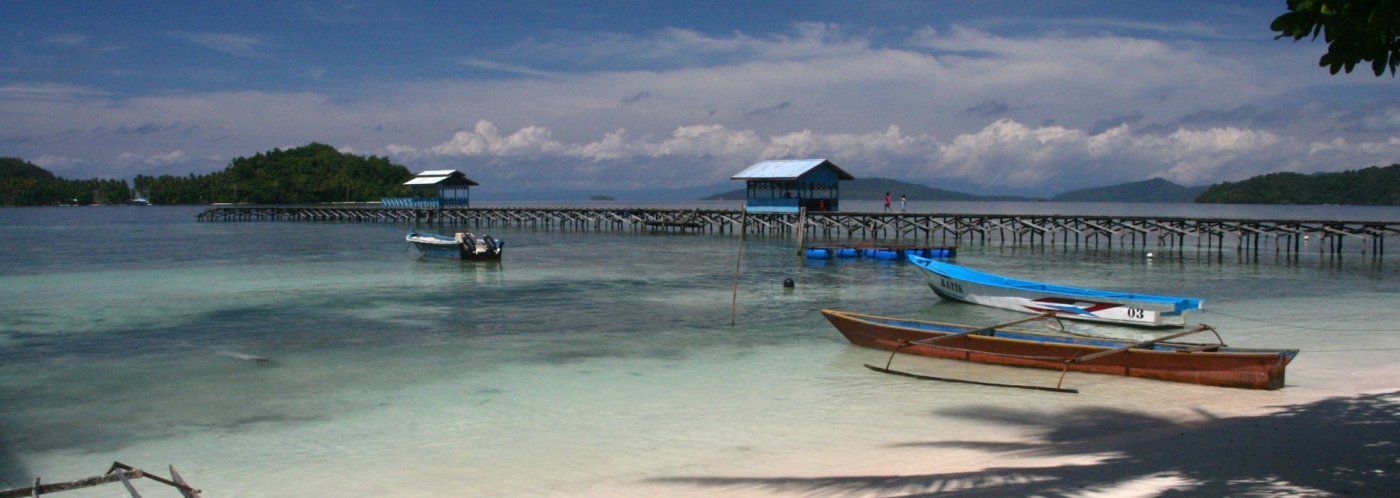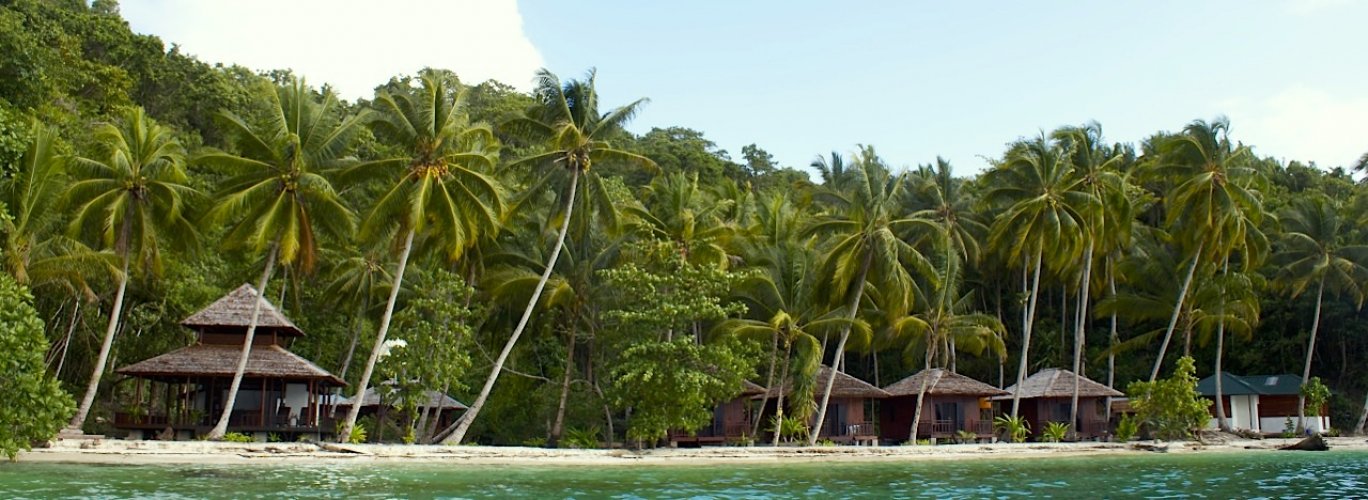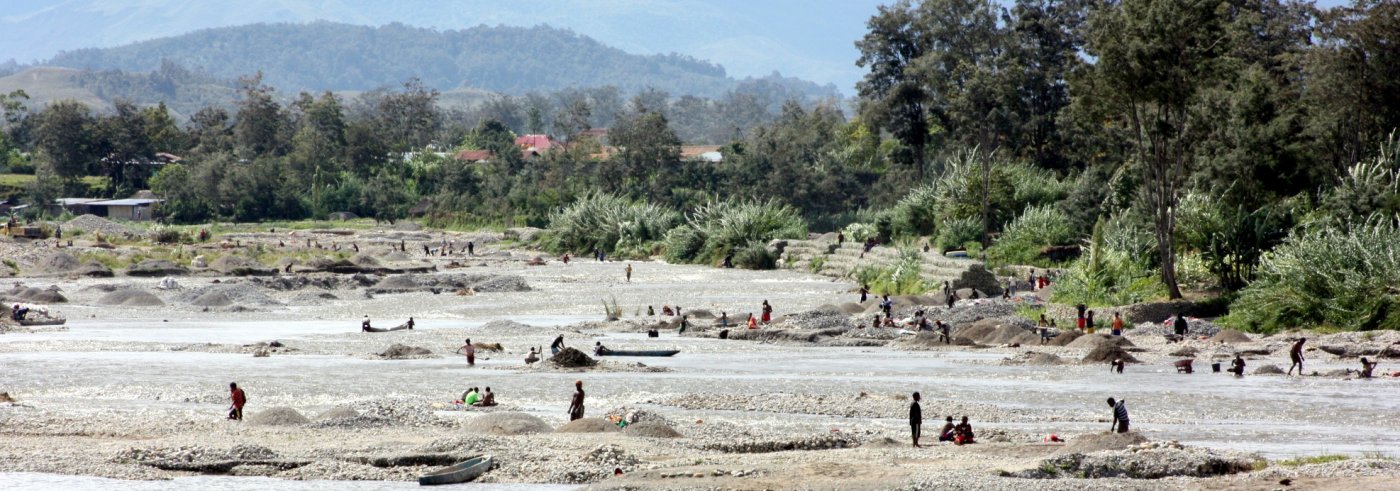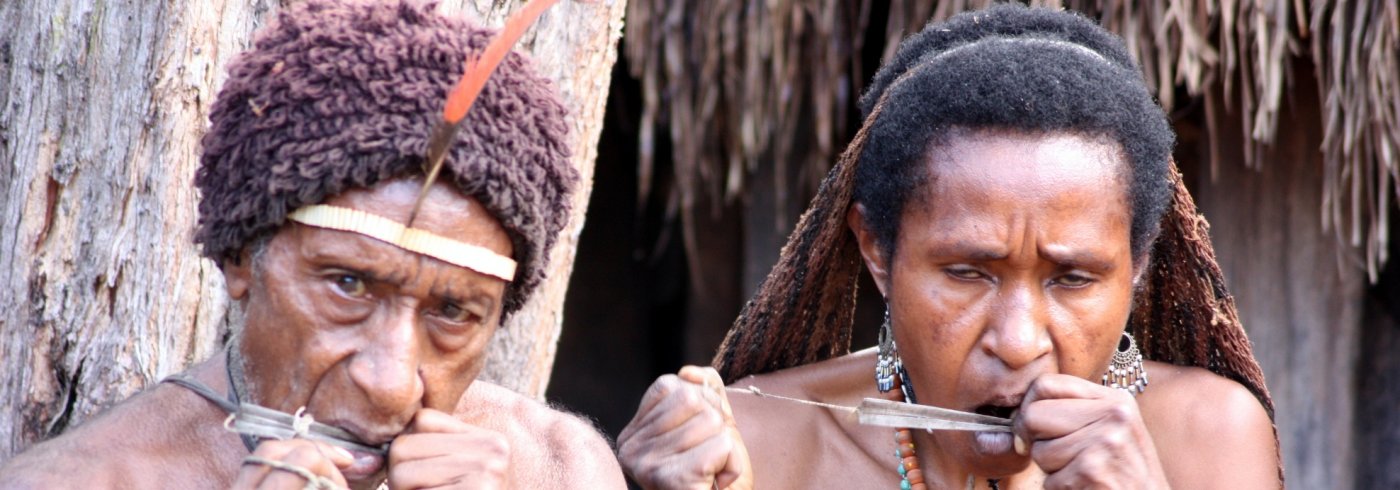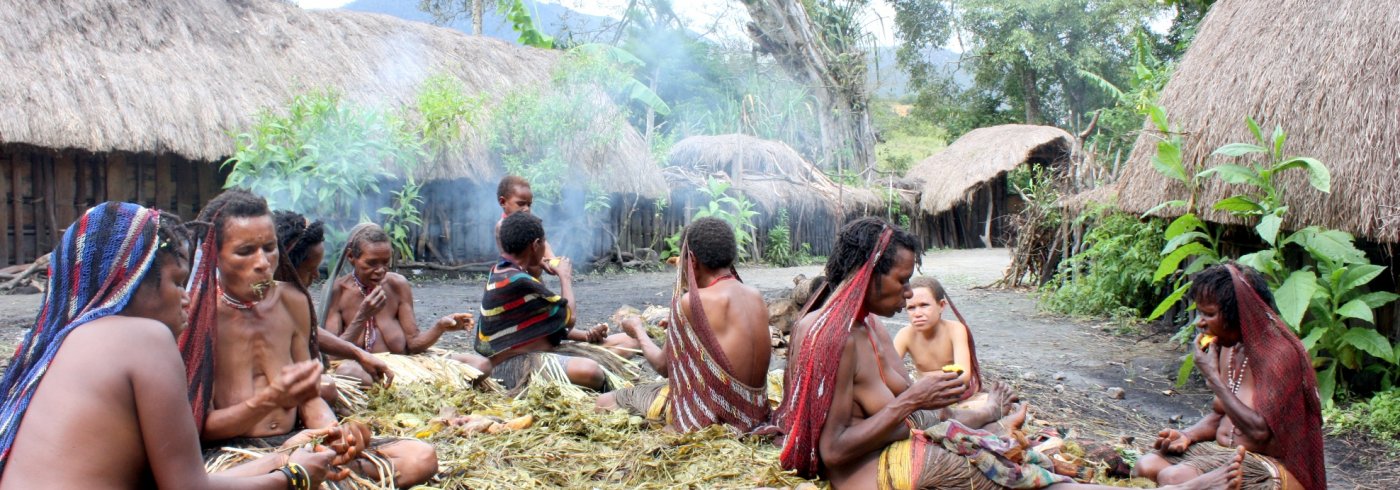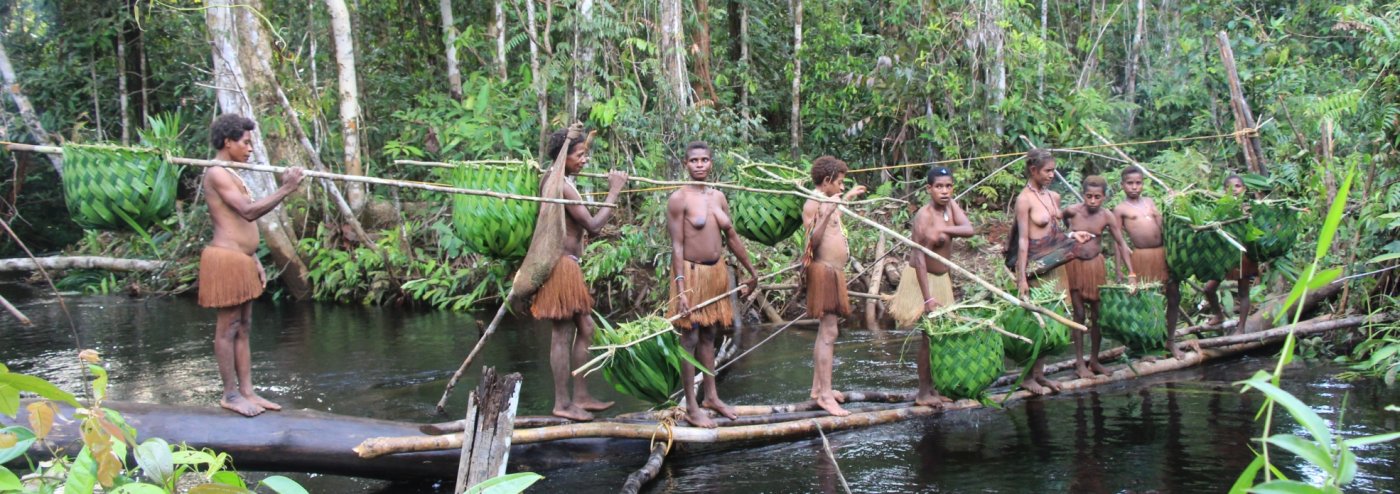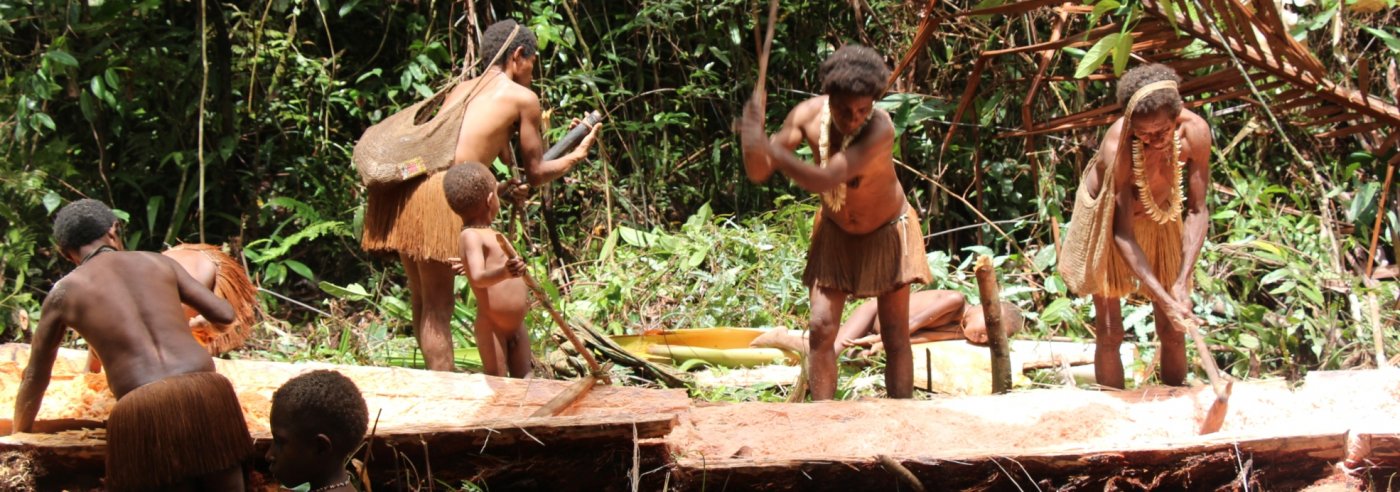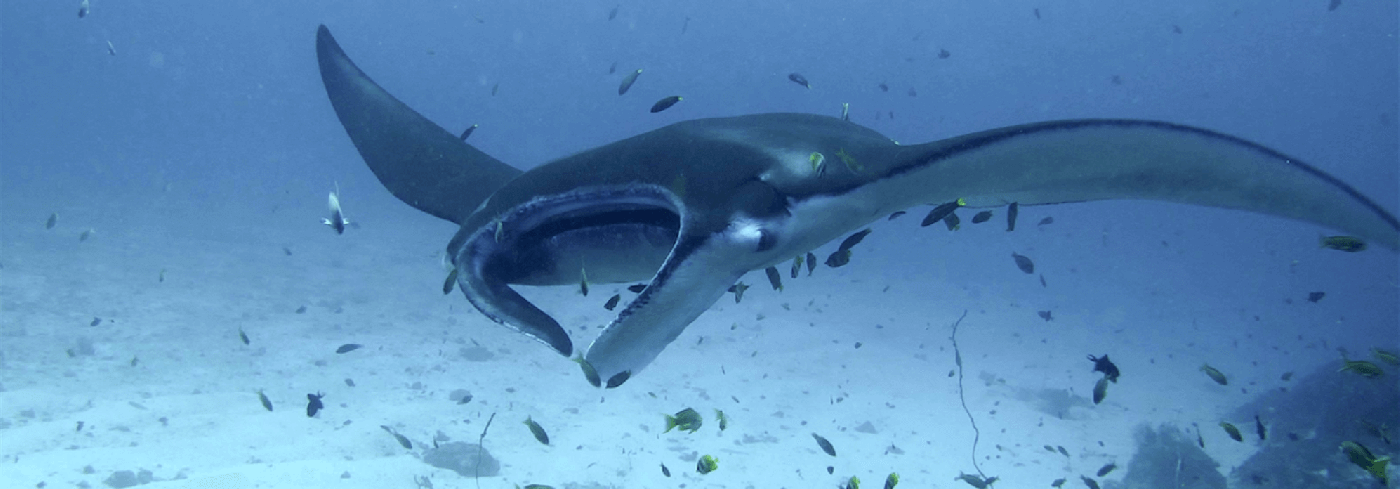Duikcruise 13 dagen ILIKE liveaboard Raja Ampat - Ambon en vice versa
Sorong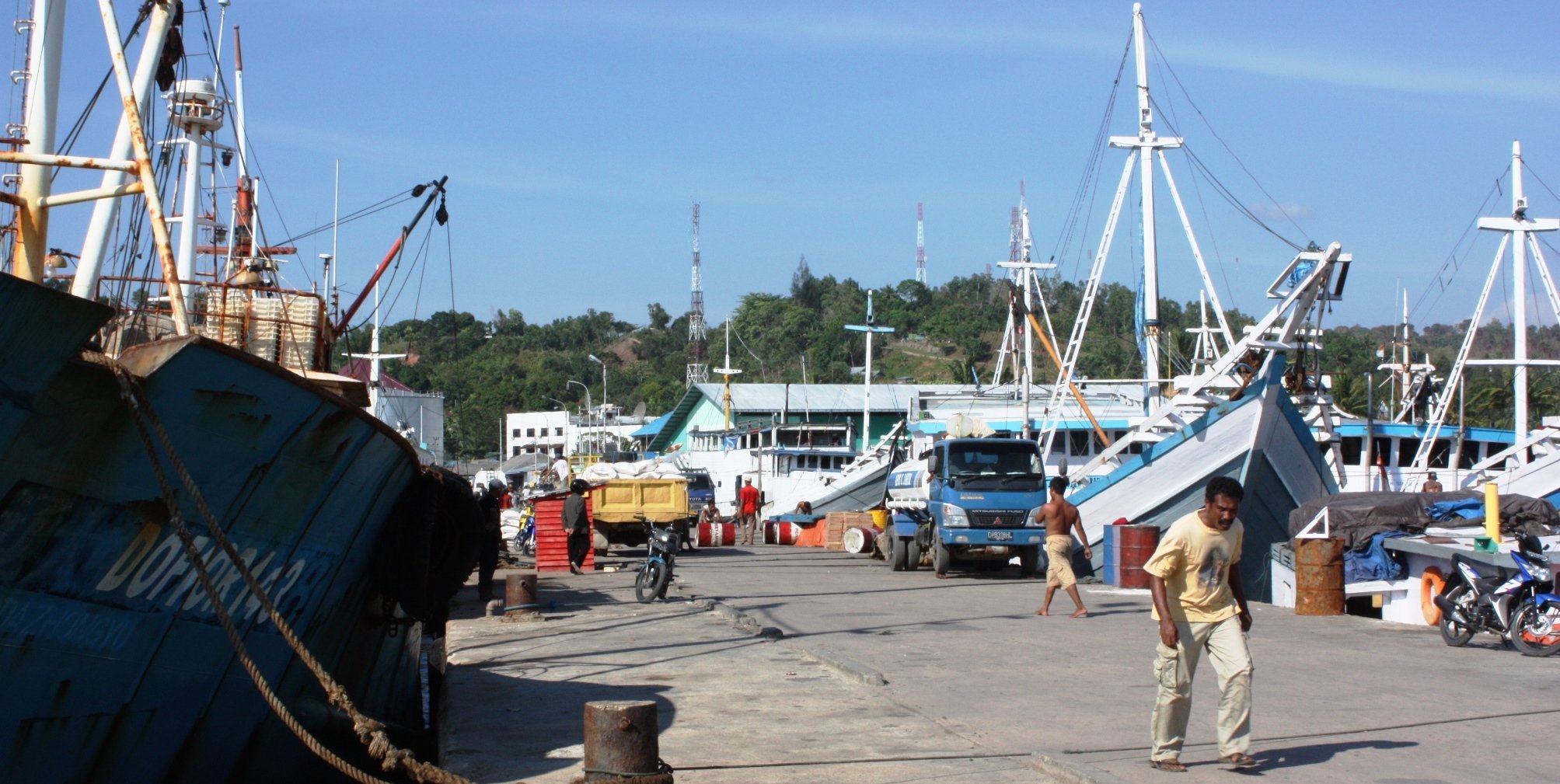 SorongSorong is the westernmost city on the island of New Guinea. The city is located on the Sele Strait of the Pacific Ocean on the Vogelkop Peninsula. It is the base for trips to the Raja Ampat Islands.Two hours' drive south of Sorong is the rainforest in the Klasow valley with all kinds of strange birds. You will find different types of Paradise birds and the endemic Cassoway, a peacock or smaller ostrich species. Sorong is the logistical center of the oil and gas industry around West Papua, which manifests itself in growing wealth and economic prosperity. The city has over 50,000 inhabitants, making it one of the larger cities of Papua. Most of the inhabitants are transmigrants from Sulawesi, Java and other islands. Directly off the coast is the island of Jefman, which until 2012 had the airport of Sorong. The new airport has daily connections with Jakarta, Makassar, Manado, Ambon and several cities in Papua, among others. Sites to seeThe city has a nice beach promenade and some historical buildings dating from the Dutch oil period. It’s a city full of contrasts. The following sights are close to the city:Cape Cassuwary: 3 km from Sorong, beach with coralreefs; Crocodile island, 500 metre out of the beach; The island Kafiau; The island Matan; The hot springs of Klaijili, 60 km from Sorong; A protected forest area, 15 km from Sorong; Sorong is the most important gateway for trips to the nearby Raja Ampat-islands and the coralreefs of the Coral Triangle. (source: Wikipedia) Tual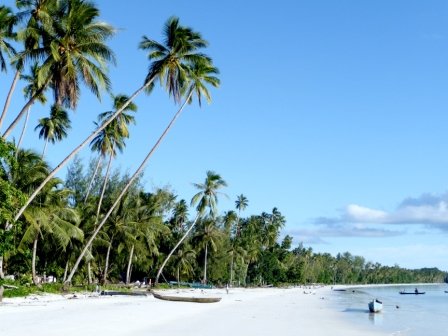 Tual - Kei KecilThe Kei islands Kei Besar and Kei Kecil (big and small Kei) have different monsoons than those on Ambon.The rainy season starts in mid-November and runs to April-May. The Kei Islands are an archipelago in the Moluccas. It is sparsely populated and very primitive. On some islands the villages are only connected by footpaths. The islands mainly offer tranquility. There is not much to see or do. Relaxing is the favorite activity of travelers visiting Kei. You can snorkel and there is even a diving center since 2017. Pasir Panjang has a flour white beach. You will find our favorite Coaster Cottages along the beach. An island tour takes you past the Pilgrim Garden John Aerts, the large Jesus statue on Masbait Hill, the natural Evu pool with spring and the Hawang cave. Langur airport has daily flights to Ambon. 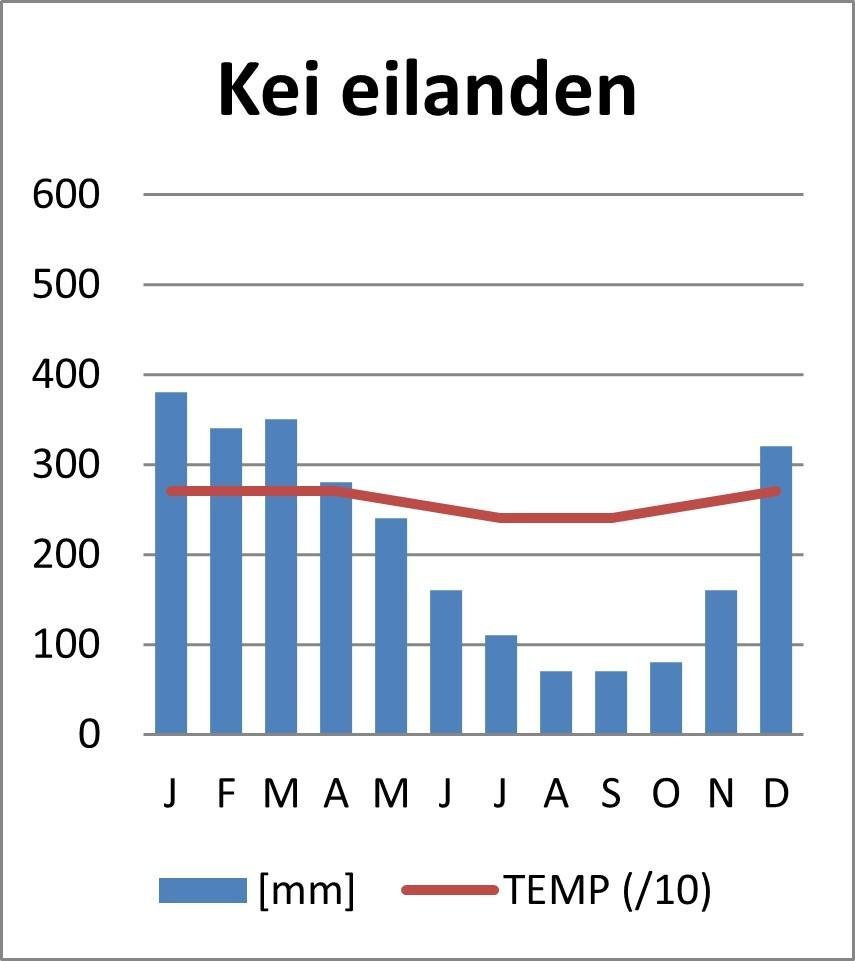 KlimaatDive spots north Raja Ampat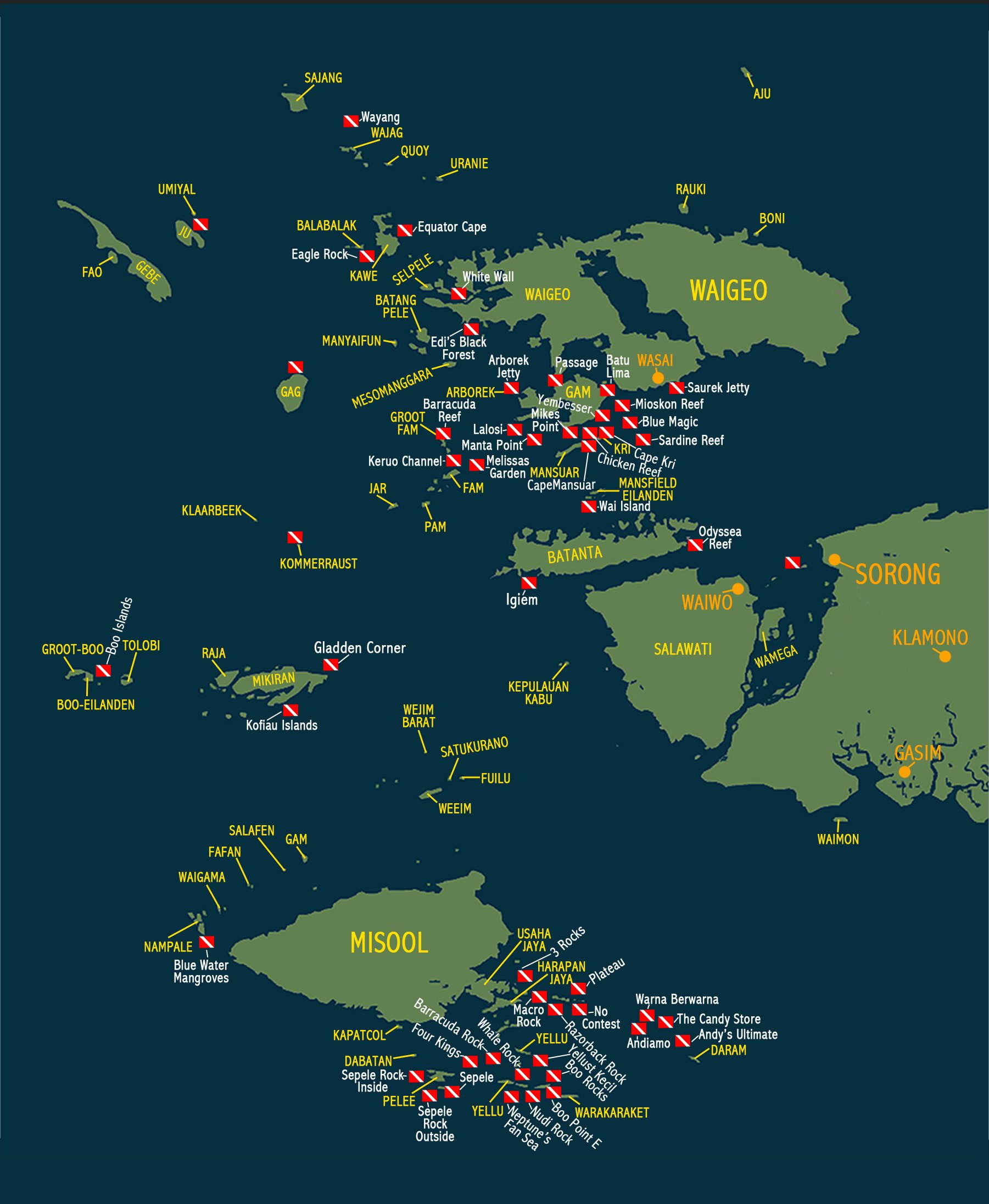 Divie spots North Raja AmpatThese days you can dive and snorkel at will in the most beautiful area of Indonesia.Between November and March a diving- or a snorkelling trip at Manta Sandy is a must! But don’t forget to admire the seahorses, wobbegong sharks, barracudas and other wonderful fish above the marvellous healthy coral as well. Besides diving and snorkelling you can book excursions to the birds of paradise or a traditional village on the spot. Or just chill out on the beach… 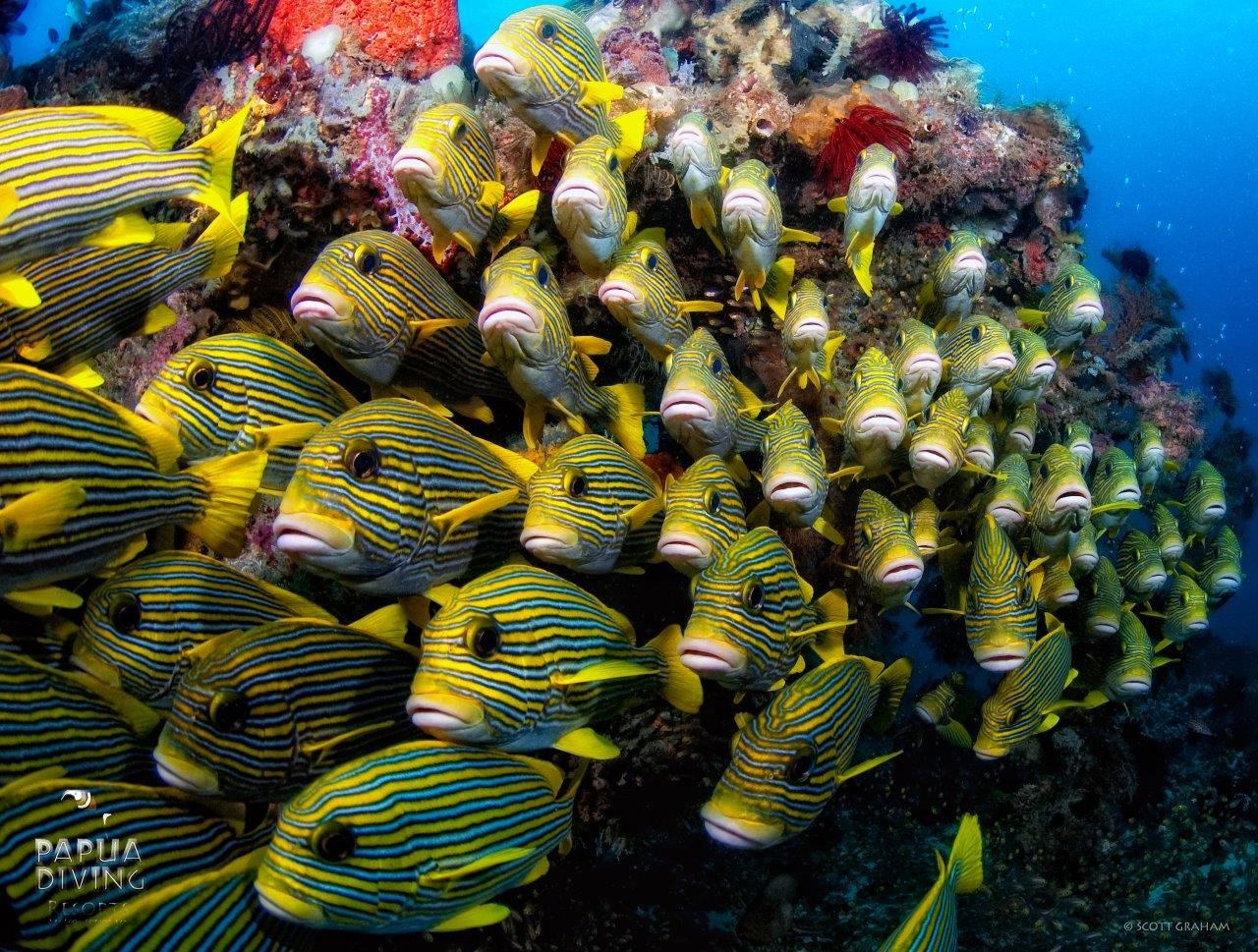 Cape KriOne of the favorite dives, Cape Kri is Sordio Bay’s house reef and less than 3 minute by boat from Kri Eco Resort. This is the dive site that put Raja Ampat on the map when Dr Gerry Allen smashed his record for total number of fish species on a single tank dive: 374 different species!The world-record holding Cape Kri, with a record count of 374 different species in one dive counted by Dr. G. Allen, is just a 1 minute boat ride from our jetty. At the Northeast point of Kri island the currents sweep into a channel between Kri and the small island of Koh. At this point beneath waters churning in the current, huge schools of Big-eye trevallies, Barracudas and Snappers can be seen hanging over the drop-off. At the base of the reef at 38 meters an ancient snagged anchor rests next to a bommie with a dense school of Banded sweetlips. A large shallow coral garden crowns the reef top with blacktip reef sharks patrolling amongst the overlapping maze of hard corals with feeding hawksbill turtles. Car-sized Queensland groupers down to the diminutive ever-present pygmy seahorse can be seen on this phenomenal and always-surprising dive site! Dawn and dusk are feeding time so divers can experience this site at its awe-inspiring best. 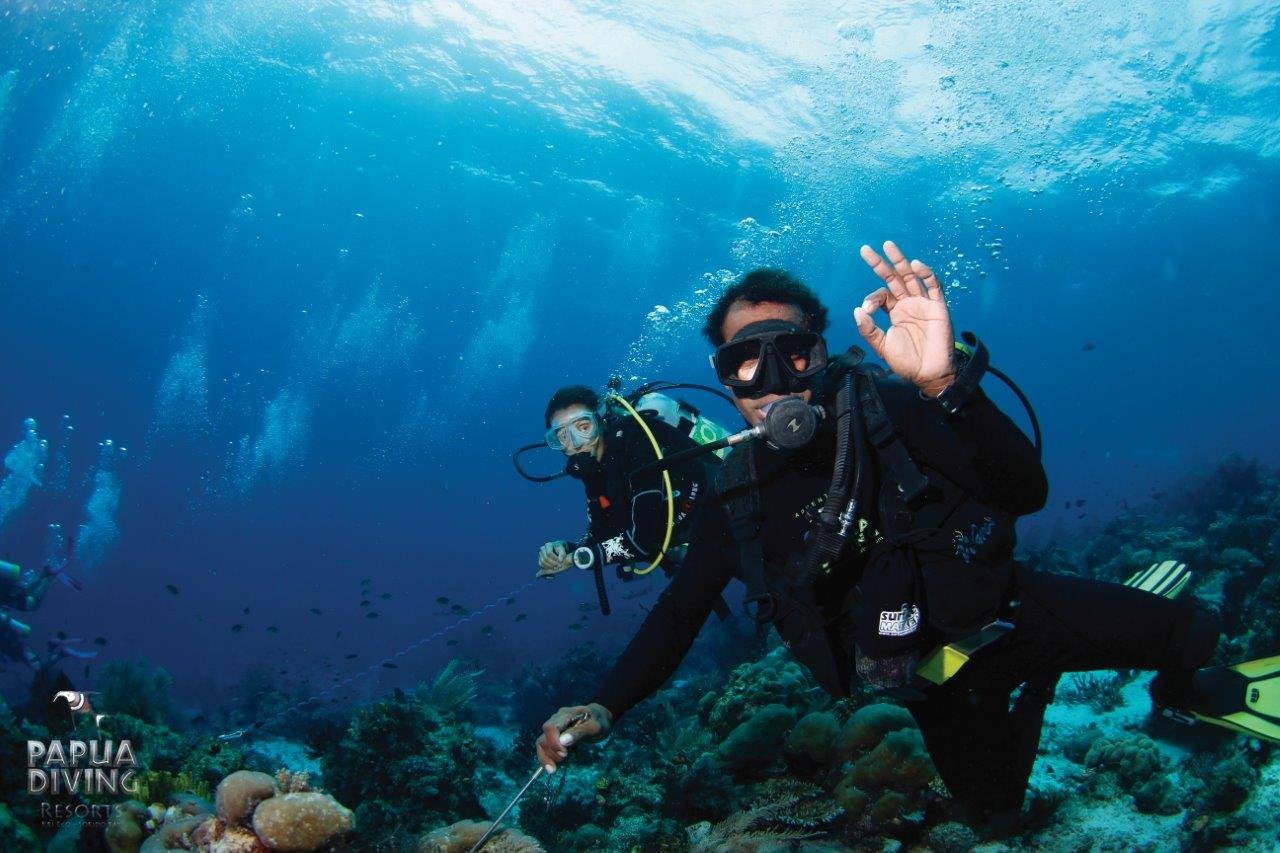 Blue magicOnly 15 minutes from Kri Island, this small pinnacle has almost everythingFrom Wobbegong sharks to tiny 2cm Denise Pygmy seahorses. The reef top is covered in hard coral with some big coral heads and some tabling Acropora corals well over 3 metres across. There is a resident school of Big eye Trevallies and many large Barracuda. Green Turtles can be found here as well as Black Tips, White Tips and the occasional Grey Reef Sharks. If you are very lucky even a Giant Manta Ray. The magnificent dive ends with a blue water safety stop drifting over and away from the reef. 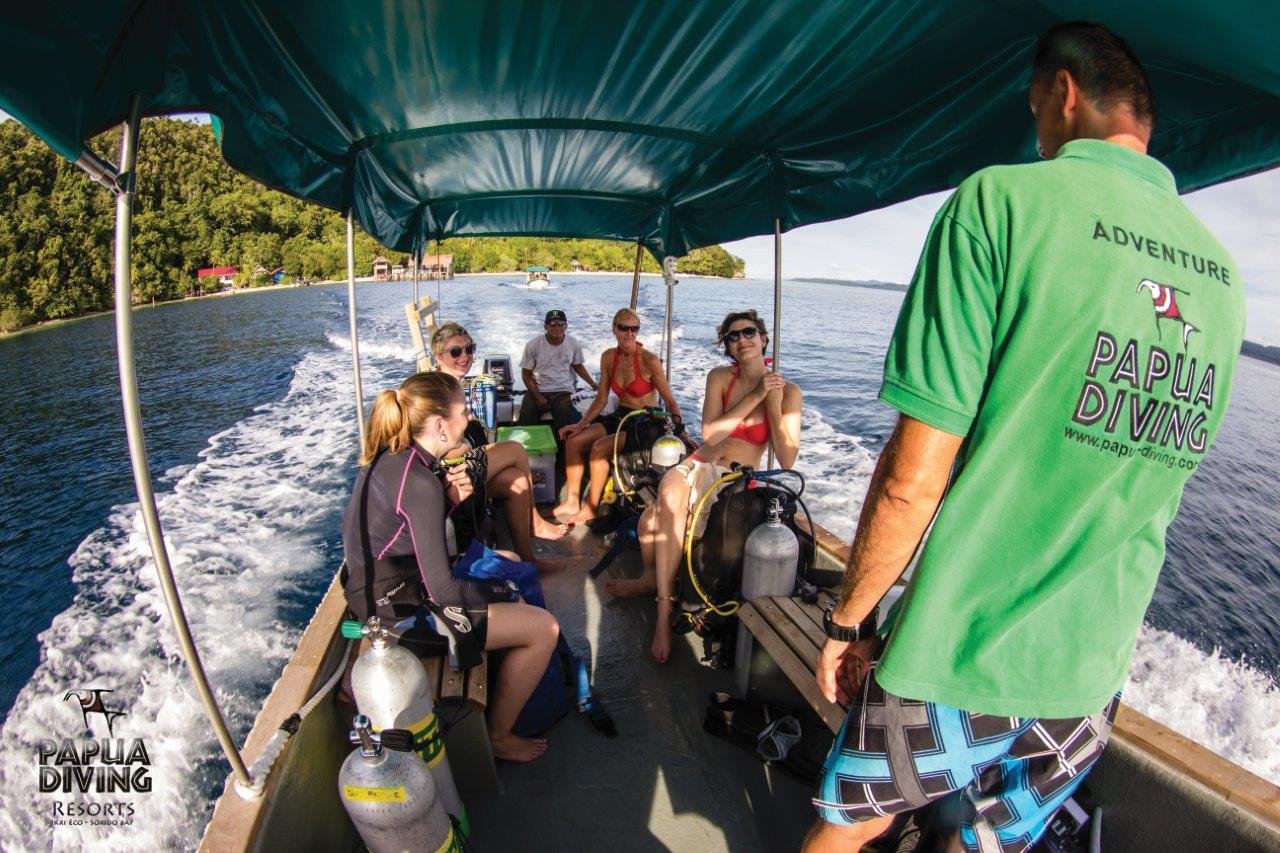 SardinesOnly 10 mins from Kri Island, this submerged reef with a reef top at 5 metres, contains a very high biomass, one of the highest in Raja Ampat.Sardines reef is quite simply one of the best reef dives in the world, where divers witness the phenomenal diversity of Raja Ampat at full force. Where the current strikes this offshore reef and splits, a dazzling array of fish congregate, audibly swarming fusiliers spin above, pursued by huge giant trevallies, packs of Bluefin jacks and huge Spanish mackerels. Batfish gather in the hundreds, while multitudes of schooling bannerfish feed in the current. Grey reef sharks, blacktips and whitetips can also be seen along with the wobbegong waiting in ambush on the sea floor. Coral bommies dot the slope covered with many colourful species of dendronephya soft corals and up to three separate species of Pygmy seahorses can be found amongst them. On the current-swept reef top a resident school of thirty massive bumphead parrotfish crunch on the coral, keeping the divers company on a safety stop who hang from their reef-hooks like kites in the wind. Upon surfacing, many divers comment that this is the best dive they have ever done!! Photographers love this dive site and have to return to change from wide angle to macro! 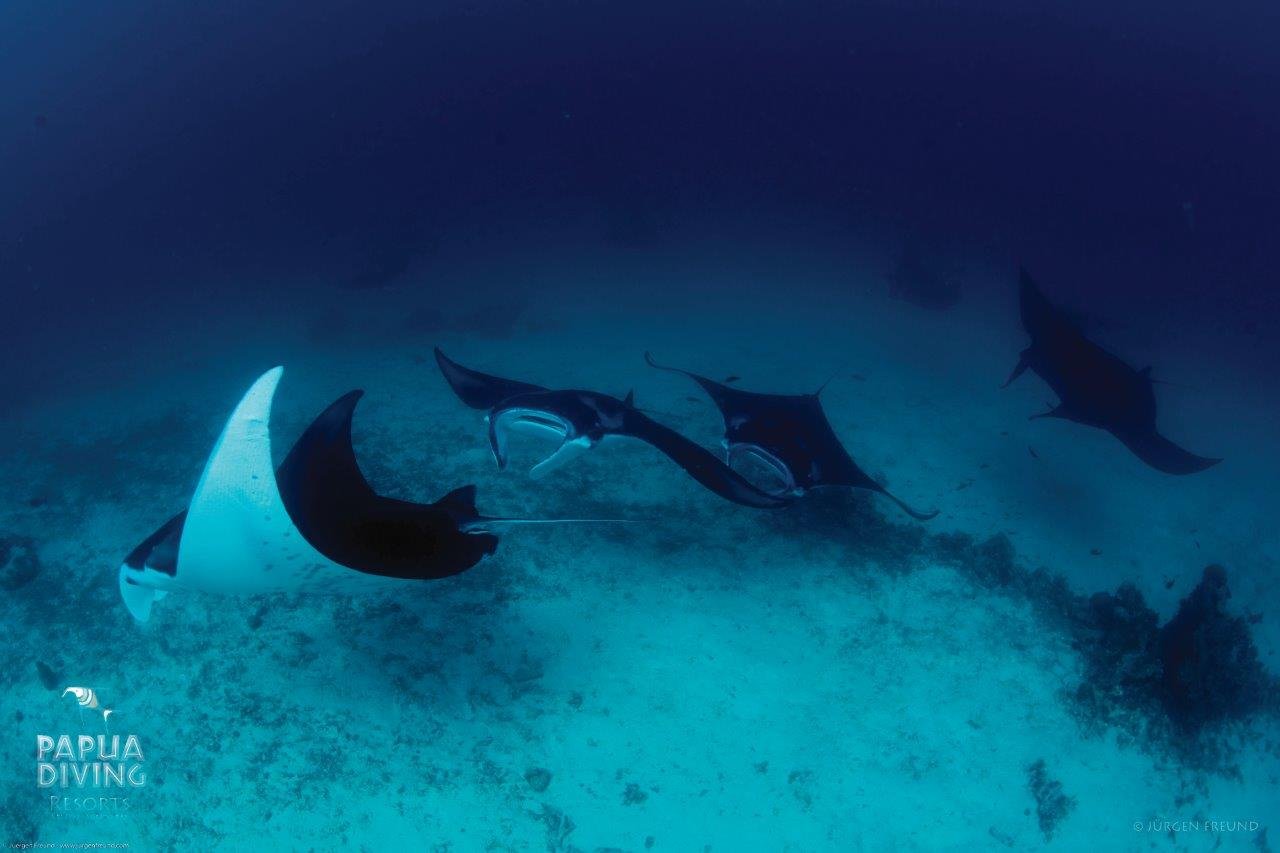 Manta SandyOnly 25 mins from Kri Island, this sandy slope is famous for its Manta Rays. It is a cleaning station where they come in to get cleaned.If the many reefs are not enough this area also boasts some of the best manta diving in the world! There are two main manta sites just half an hour away. One, Manta Sandy, is a cleaning station where up to 10 mantas can be seen vying for a position above the two rocks where wrasses clean these giants. We get enormous 4 meter wide black mantas, looking like a negative photographic image, their gills are highlighted in white, along with the other more common white-bellied variety. Another site nearby, Manta Slope, mantas circle above in the sun while divers hook onto the reef while the current arcs overhead and down the steep slope below. Divers can be caught unaware while giant demonic-looking black mantas cruise by behind them. This trip is out of our 10km range, but is offered once a week without any fuel surcharges! 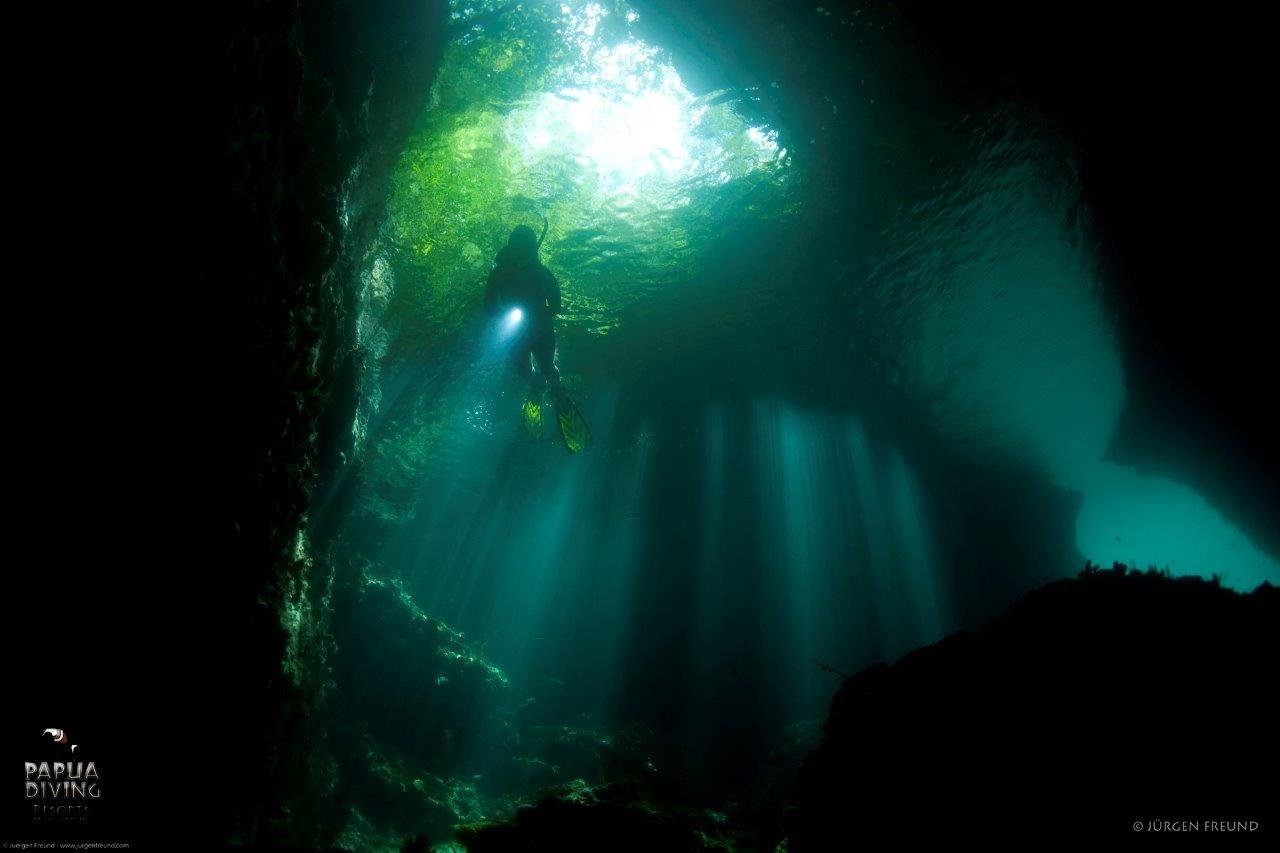 The PassageAs seen in many articles, including recently by David Doubilet in the Sept 2007 National Geographic, the passage is a completely unique dive site. The narrow canyon 40 minutes away between Gam and Waigeo can be described as river flowing between the two Islands, but also a marine environment, a haven of peculiar and unique microhabitats.This is a place where experienced divers and photographers enjoy the utterly different experience of diving in this truly one-of-a-kind location. Above water the sheer limestone cliffs make this a place where the sightseeing above water is also excessively beautiful. Guests combine this trip visiting the labyrinthine Hidden Bay, a maze of towering islets, and Kabui Bay where literally hundreds of mushroom islands create staggering scenery. This trip is out of our 10km range, but is offered once a week without any fuel surcharges! 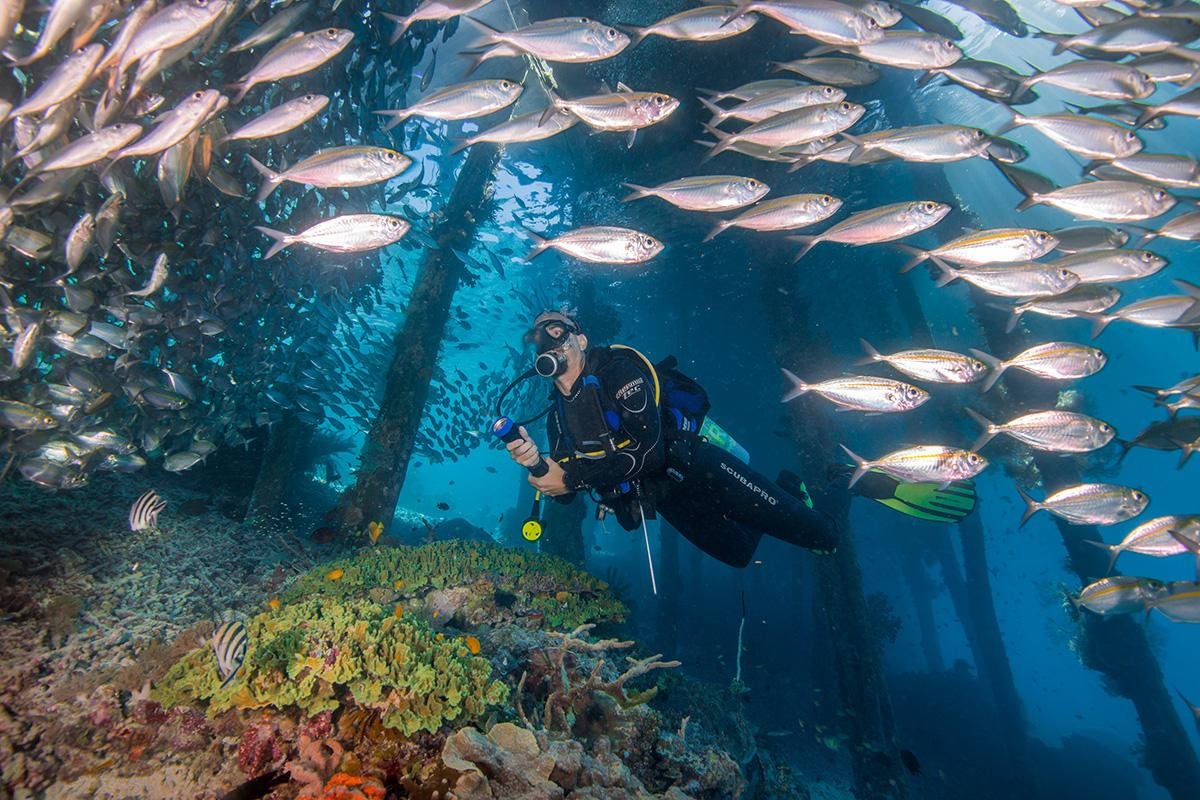 Arborek JettyDirectly below the jetty of the mini-island of Arborek you will find large schools of Sweetlips, Barracudas and hunting Mackerel. The soft coral also hides Pipefish, Snappers, Batfish, Bumphead cattlefish and if you are at the right time and place you can also spot the Wobbegong.Misool Duikstekken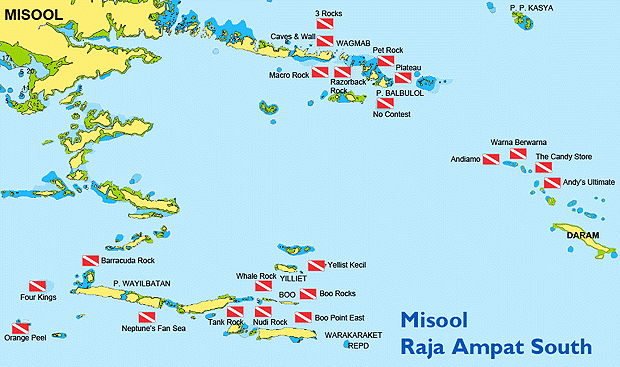 Misool duikstekken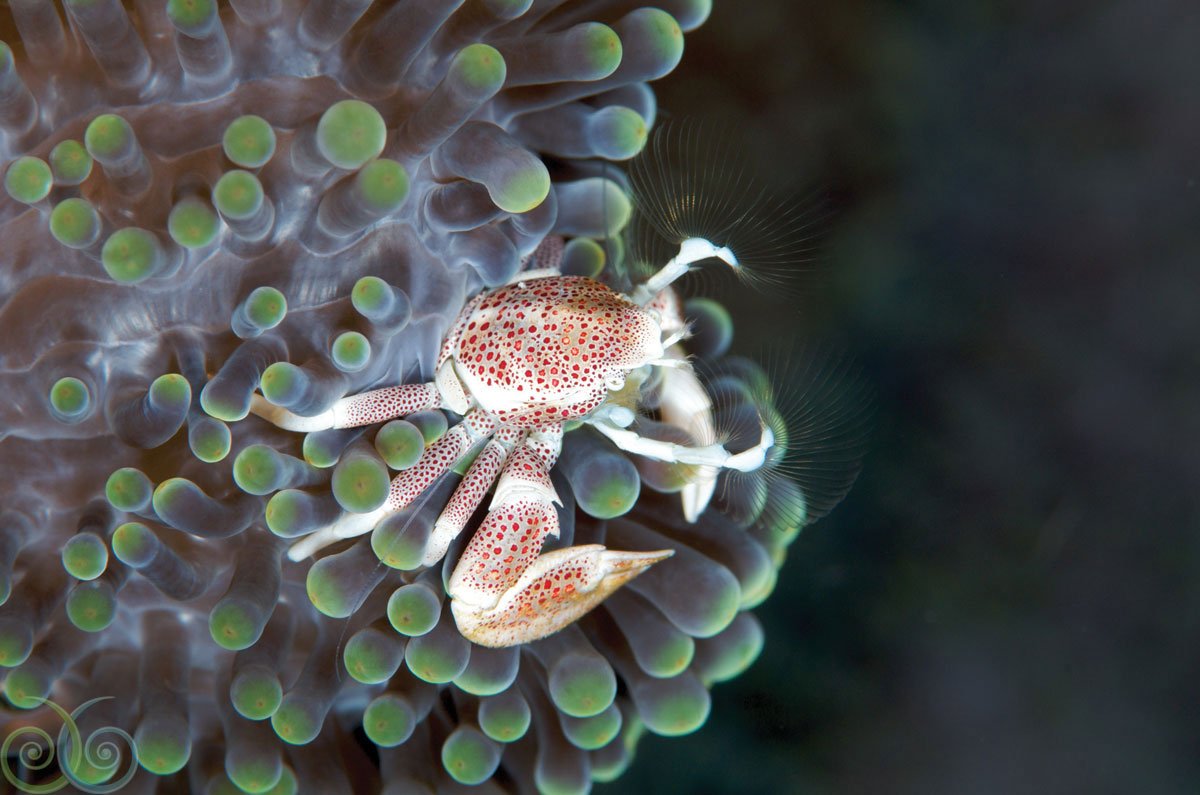 Misool eco resort house reefOur House Reef is a shore dive, easily accessed at any time from either the end of the jetty, the Dive Centre, or the steps leading down from your Water Cottage accommodation. On a rising tide, jump off the end of the jetty and enjoy an easy drift North through the channel, which is exposed to variable current. Schooling horse-eyed jacks congregate under the pier, joined by massive schools of fusiliers and shoals of passing anchovies. Several very large groupers make their home in the depths under the jetty, and they often appear to inspect visitors to their reef. We regularly see large black tip reef sharks patrolling the deeper areas, as well as the occasional grey reef shark.Our House Reef is a shore dive, easily accessed at any time from either the end of the jetty, the Dive Centre, or the steps leading down from your Water Cottage accommodation. On a rising tide, jump off the end of the jetty and enjoy an easy drift North through the channel, which is exposed to variable current. Schooling horse-eyed jacks congregate under the pier, joined by massive schools of fusiliers and shoals of passing anchovies. Several very large groupers make their home in the depths under the jetty, and they often appear to inspect visitors to their reef. We regularly see large black tip reef sharks patrolling the deeper areas, as well as the occasional grey reef shark. 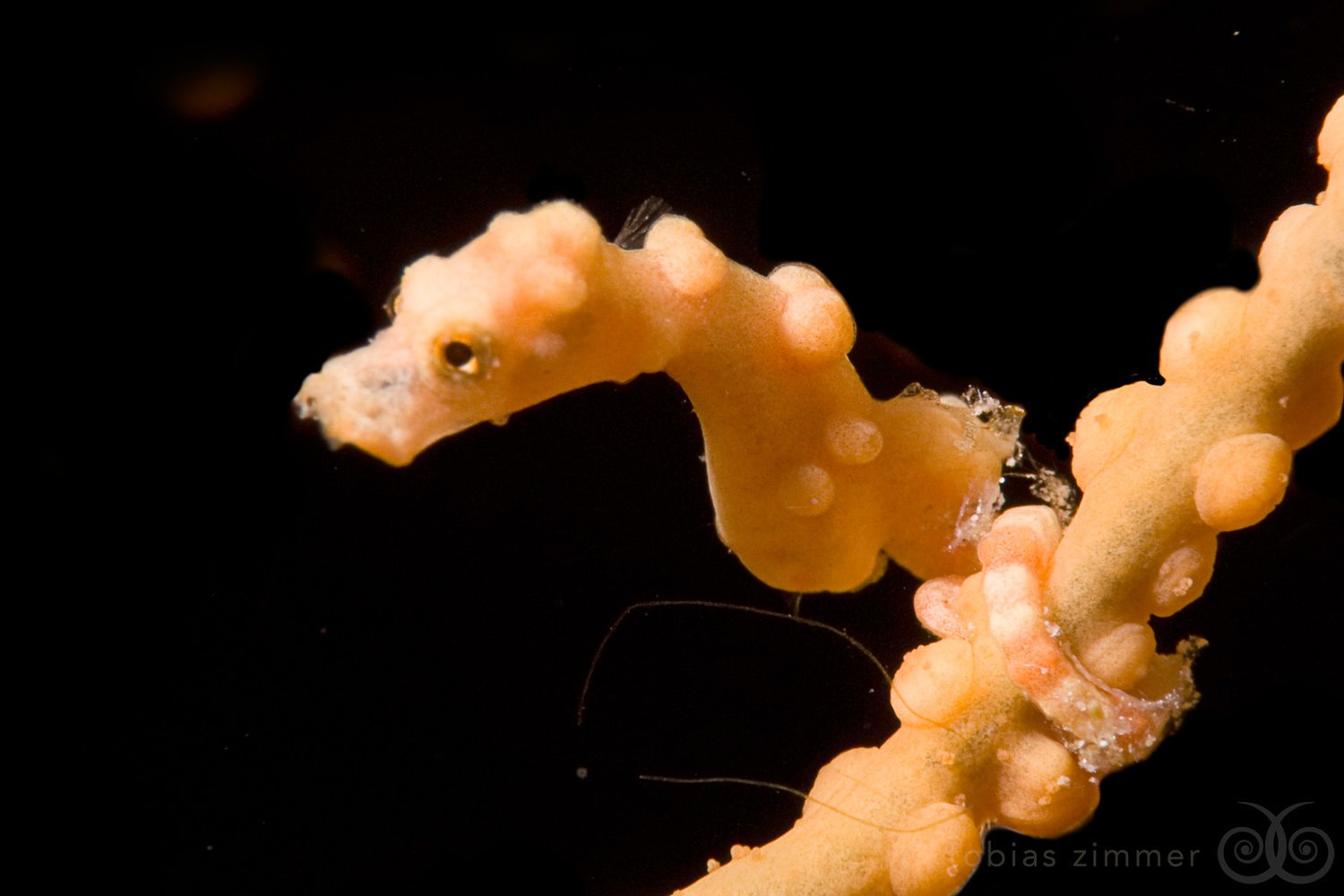 Nudi Rocka small island in the Fiabacet chain, which looks an awful lot like a nudibranch from a distance. Just a quick 5-minute speed boat ride from the jetty, this site is a must for critter enthusiasts and macro photographers. True to its name, you'll find a wide range of flamboyant nudibranchs lurking among the abundant soft corals. The sea fans are well populated with pygmy seahorses and cowries. Be sure to inspect the abundant crinoids for their colour-coordinated arrowhead shrimp and cling fish. When currents allow, this site is also popular for its pinnacles crowded with larger pelagics like Barracuda, Big Eyed Travelly, and the odd mature Grey Reef Shark. The sloping shallows of Nudi Rock are stunning for wide angle shots with exquisite colours and hard coral gardens.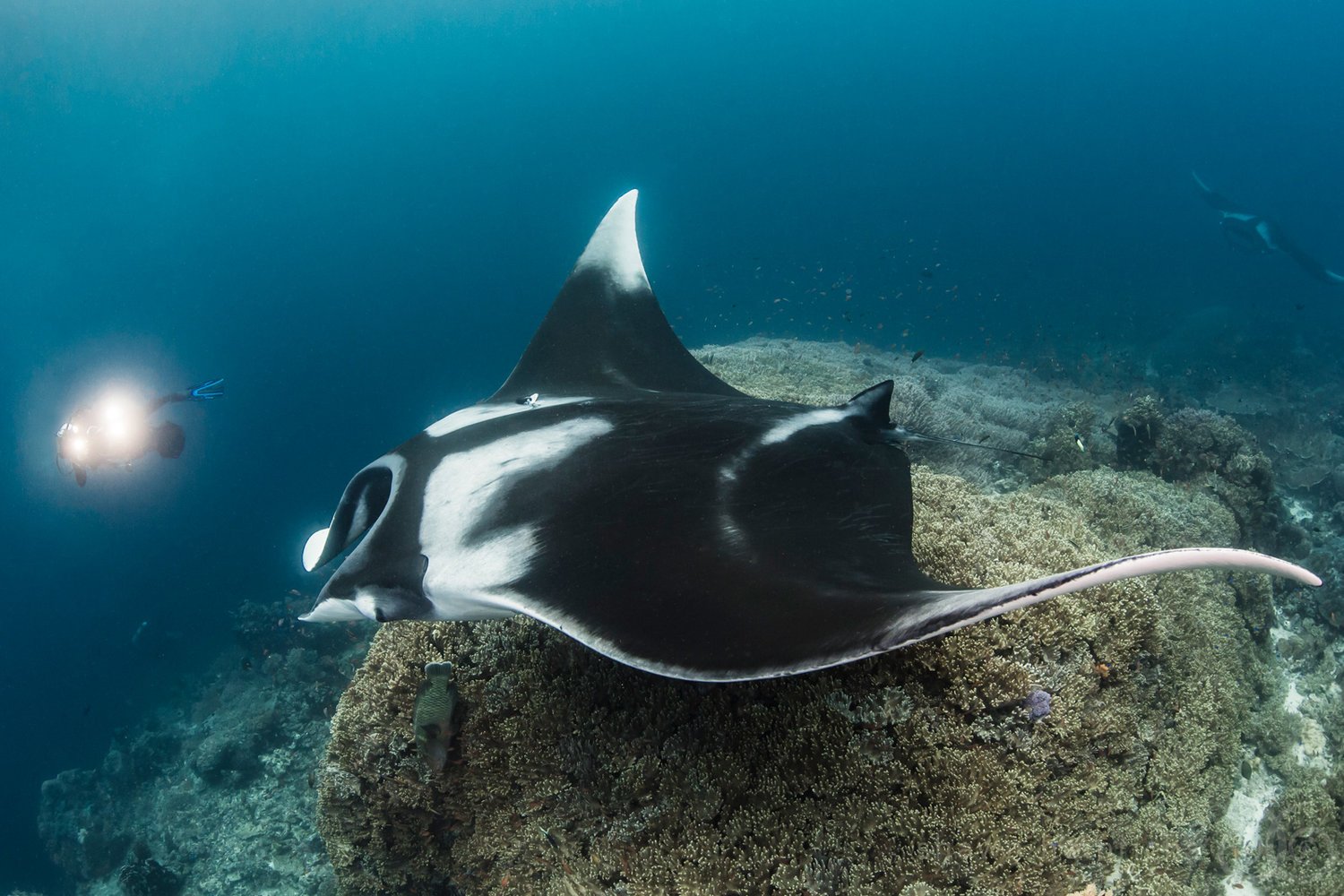 Magic MountainThis sea mount is located about 20 minutes from the resort, and is a busy Manta ray cleaning station. The submerged pinnacle reaches up to about 7 meters, and you have a very good chance of seeing not one by TWO species of manta rays here - both the giant Oceanic birostris as well as the smaller reef manta, alfredi. Magic Mountain is also a nursery for White Tip Reef Sharks and a love nest for Napoleon Wrasse. Because this site is completely exposed to oceanic currents, you can expect to see large schools of pelagics in the blue.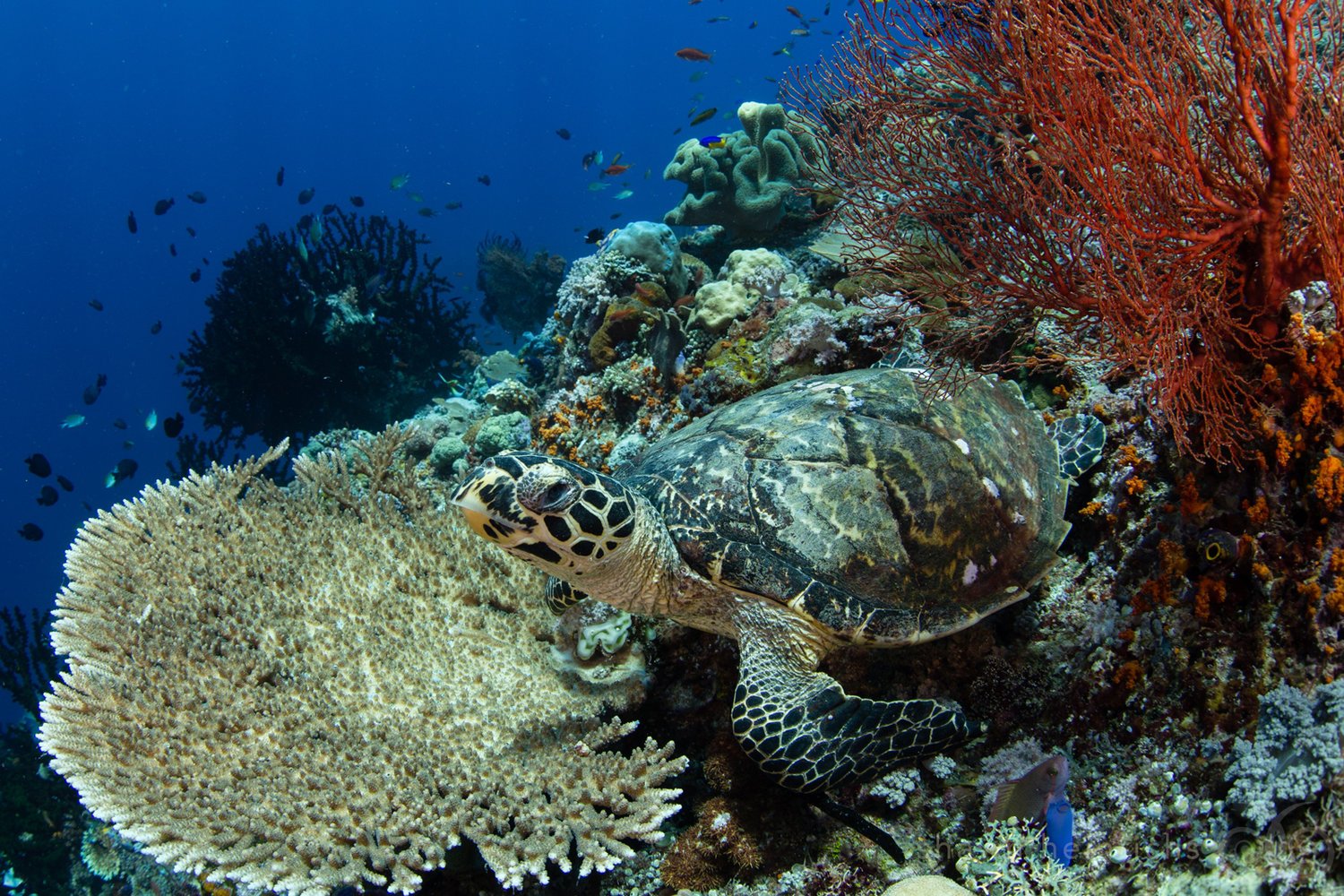 YilletThe huge island of Yillet stretches east to west about 15 minutes north of our resort island. This island used to be home to an itinerant shark finning camp, and we are pleased by the stunning resurgence of life on its surrounding reefs, including sharks. One of Yillet's tiny satellite islands is particularly rich and topographically weird. The tiny island has been undercut by untold millenia of wave action, forming an umbrella over a sloping underwater plateau with numerous spooky overhangs and cavelets. Diving with a torch is highly recommended for this site - you'll want to illuminate the dark corners of this site to see all the critters, as well as the wild colours. Barramundi cod and Hawksbill Turtles frequent this site. We also suggest you keep a sharp eye on the blue, as huge schools of barracuda hover in formation.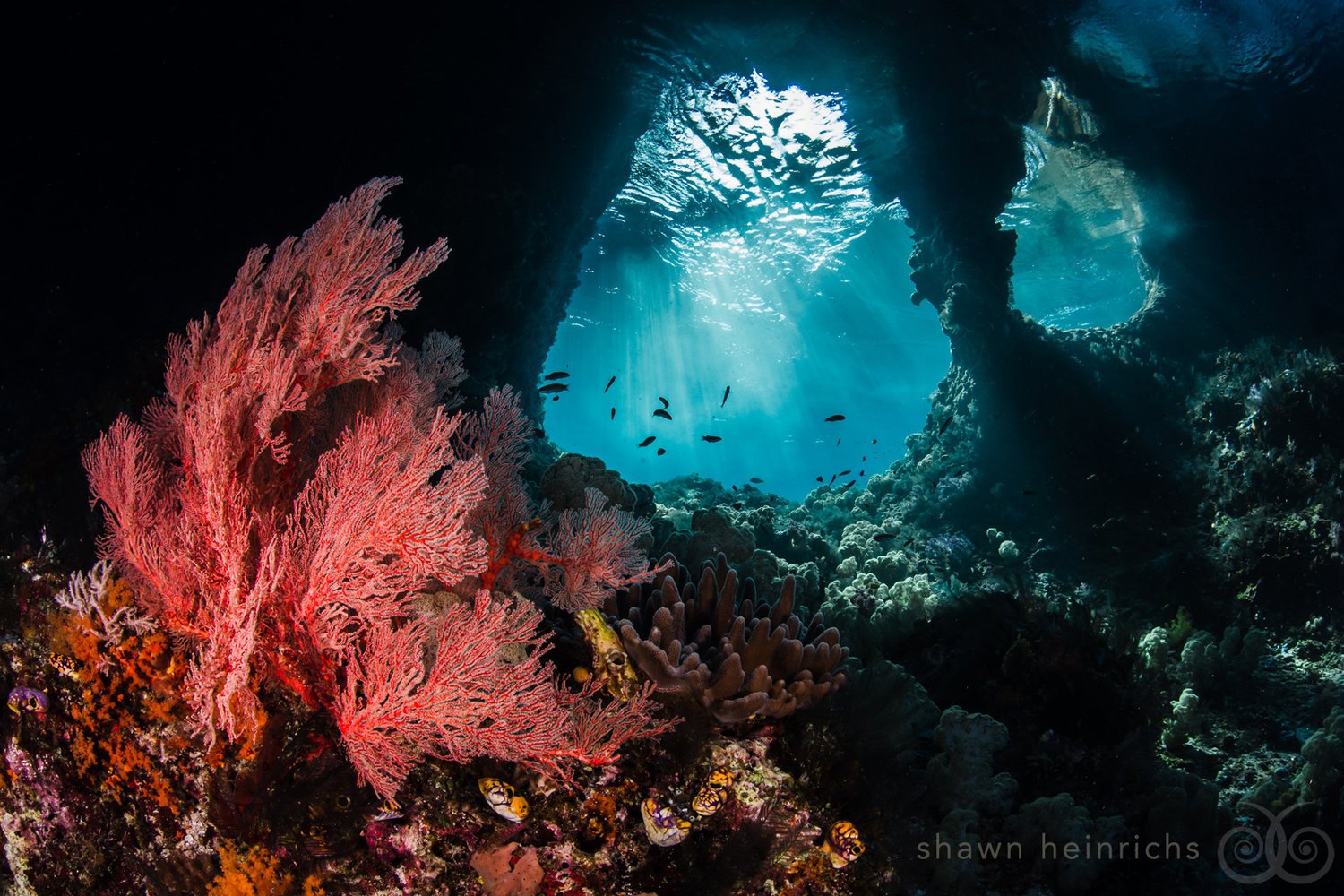 Boo WindowsOne of our most famous dive sites, named for its unique topography. The site is a small island about 15 minutes from the resort, with 2 swim-through 'windows' carved into it. The South West face of this site is quite steep and exposed to current, so you are likely to see patrolling sharks as well as the elusive Wobbegong Shark - be sure to look under the massive table corals! When the currents are right, we'll move off towards a large pinnacle in the blue. The pinnacle is often surrounded by pulsating schools of fusiliers and gangs of plate-sized Batfish. Heading back towards the Windows, notice how the sunlight filters through - it's like nothing else on earth! We'll follow the plateau of hard plate corals and look for Sweetlips hiding underneath. Be sure to investigate the huge Barrel Sponges - their crevices often conceal Hairy Squat Lobsters.Pulau KoonPulau KoonKlein eilandje tussen Kaimana en de Banda archipel. Geliefde duikstop voor liveaboards tussen Raja Ampat en de Banda archipel.Dive spots Banda archipelago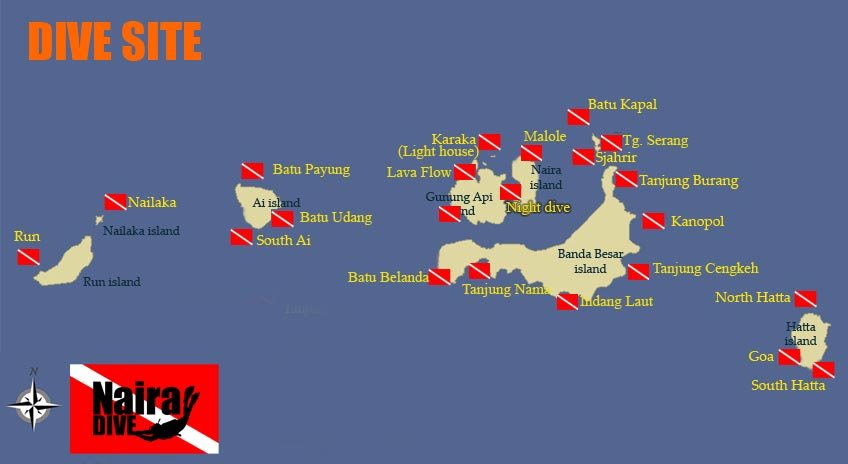 Dive informationDive Season: The best months for diving are September to early December and March to April but also the months between. October and November are the best months to spot large schools of hammerheads. The Moluccan islands have the seasons reversed from the rest of Indonesia, when they have the dry season, its rainy season in Indonesia.Visibility: Usually is good (20-30m) except some muck sites close to the harbour or where sand is easily stirred up. Water Temperature: 20C/68F – 27C/80F Skill Levels: Dive sites are available from beginner through advanced. Dive Access: Land based diving, boat diving and shore diving. Many live-aboard start and end their itinerary in Ambon. Good option to add land based diving at the beginning or ending end of you live-aboard trip. 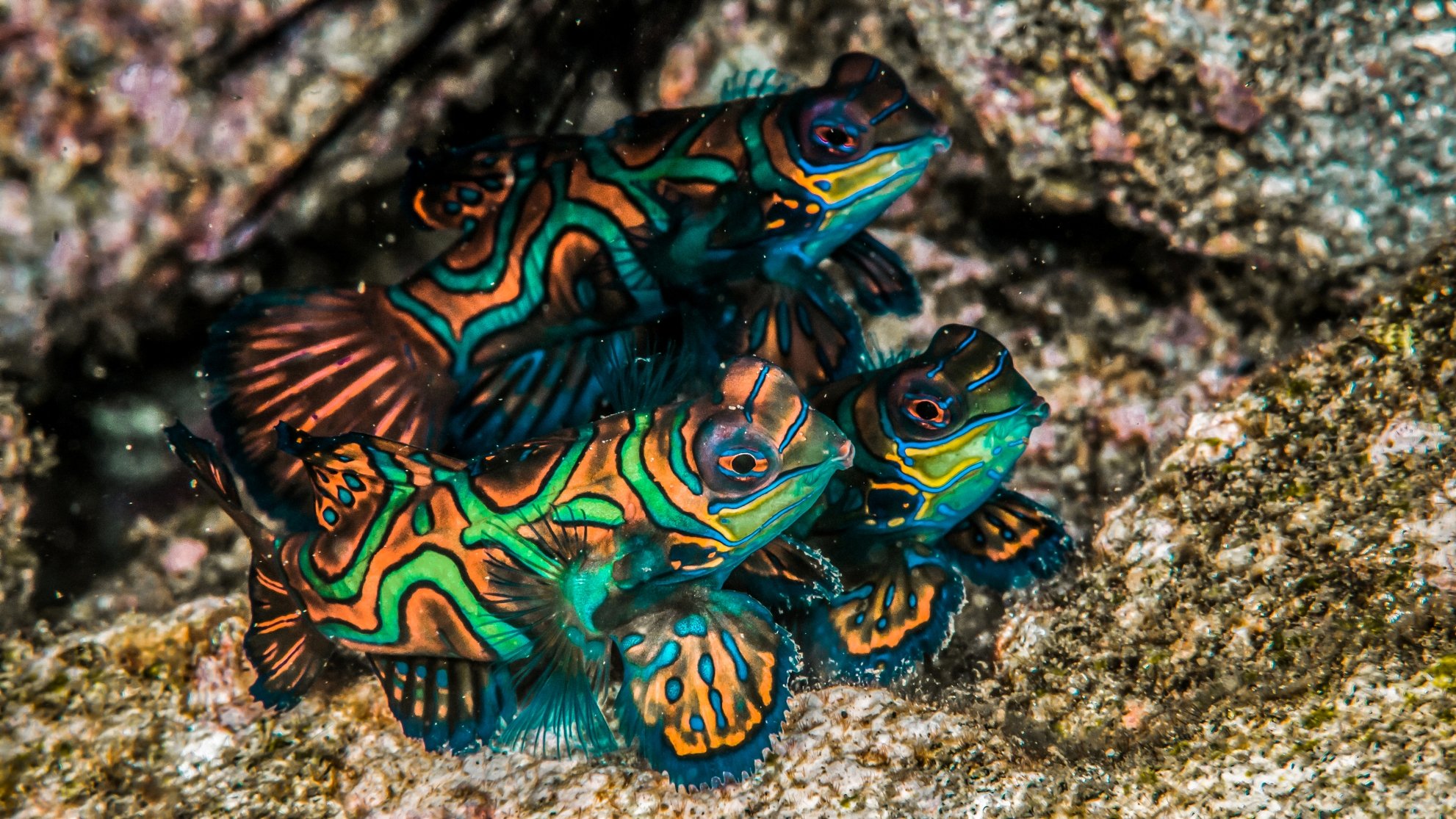 Mandarin cityJust in front of Hotel Maulana , you find a dive site that we call Mandarin city because it is nearly impossible to miss the colourful Mandarin fish living here. If you go for a sunset dive the chances are great you become witness of their daily mating activities. In the vicinity of the Mandarin fish’s home is the main pier of Banda Neira. It is overgrown with ascidians, sponges and soft corals and hosts juvenile batfish, crocodile fish, a variety of different scorpion fishes, hundreds of pipefish, large moray eels, and so on. There is still so much to discover that it is always worth getting a tank and jumping in directly in front of the dive center.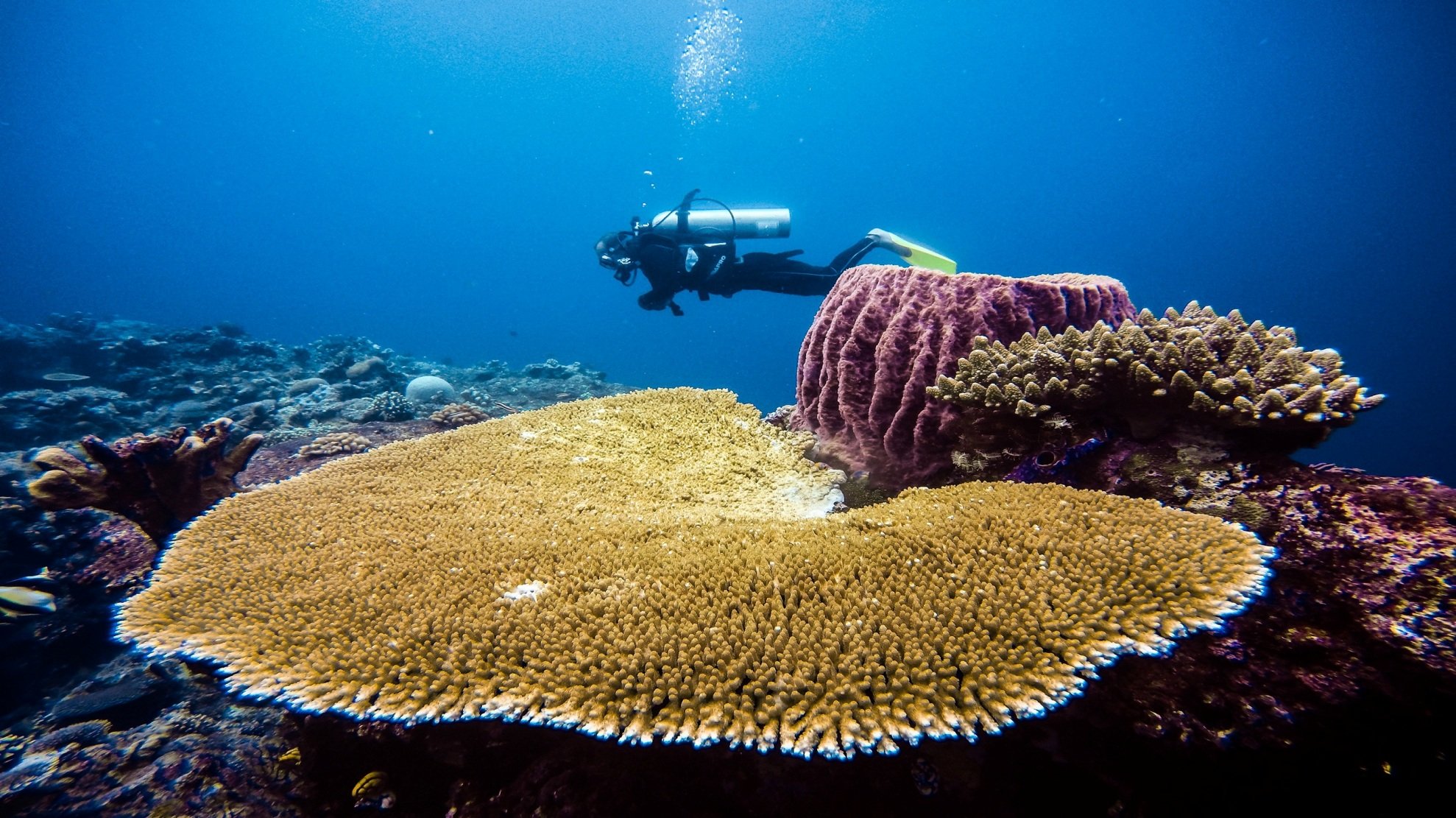 Pulau Pisang“ Pulau Pisang, the “Banana island” is just a 20 min boat ride from Banda Neira and is surrounded by healthy and species-rich coral reefs that are home to a larger number of colourful reef fish such as Butterfly-, Surgeon-, Trigger-, Parrot- and Angelfish. The reefs are also considerd to be part of Banda’s top spawning grounds. The reef slopes are all ending in a wall going down to 25-50m, which is covered with Gorgonians, sponges, anemones, whip corals, and so on. The dives here are usually moderate drift dives with strong currents only at the most northern and southern tips of the island. Banda BesarBanda Besar offers a number of beautiful coral dive sites with hard coral reefs usually ending in a soft coral-, sea fan- and barrel sponge- covered wall. Along the southern coast aggregations of fish such as rainbow runners and redtooth triggers can be found. Napoleons are also frequently encountered at most of the dives sites. Some dive sites to be mentioned here are Karnopol, Tanjung Cengke, Batu Belanda and Pohon Miring. Apart from its beautiful wall and its large cave that can be discovered at a depth of 10 meters, Batu Belanda is famous for some eagle rays that are often “flying by”. Pohon miring, on the northern tip of Banda Besar impresses with its picturesque rock structure as a colourful and large swim-through can be found here. Pohon miring is also a point where the currents from the southern and northern site of the island meet, which attracts a lot of fish.The Lava flow in the north of Gunung Api is probably one of Banda’s most extraordinary dive sites. After the volcano erupted in 1988, the gravel on the bottom of this dive site was covered with lava. Very soon, corals (mostly Acropora) started to grow on the cold lava and since then have formed a huge coral reef with nearly 100% hard coral cover. Why corals were able to grow so quickly is still not totally clear but the surface structure of the lava seems to play an important role. This dive site demonstrates very well how succession in a coral reef can take place. It is not only interesting for coral experts but is also a must for every diver who is visiting the Banda islands. 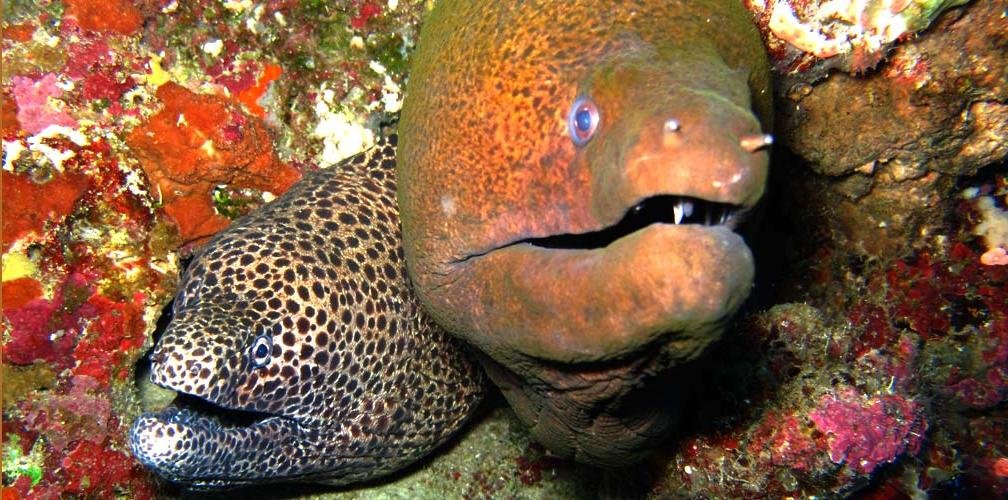 Batu KapalThe dive sites of Batu Kapal belong to our personal favourites. Batu Kapal is a rock sticking out of the water north of Pulau Pisang. Below the surface, deeper rocks and boulders can be found. The largest of them is located west of the main rock. It starts on 8m and its peak can easily be seen from the surface. It is connected to the next deeper rock northwards. Both are forming a valley in between them and both are going down to more than 50m. Huge gorgonias and barrel sponges grow on the walls, hosting big Moray eels and the biggest population of red tooth trigger fish we have ever seen. The eastern side of Batu Kapal forms a channel with some boulders. The wall of the channel is colourful and rich in fish and invertebrate species. For example, 4 differently coloured scorpion leaf fish have already been found on the dive site. The safety stop area close to the main rock is also an eye catcher as most of its boulders are covered in bright orange soft corals.In general, Batu Kapal stands out because of the amazing visibility that often reaches 40-50 m. This is also the place with a chance to see larger pelagic fish. However, Batu Kapal is also known for its strong changing currents that make diving impossible some times of the day. Quite a few things make this place one of the top dive sites in Banda. A steep slope covered with coral, a straight and spacious 15-meter long swim-through full of gorgonias that exits next to a beautiful wall covered with sea fans and huge sponges, a rocky plateau full of small critters where big Napoleons and other fish like to play with the current and an amazing visibility that makes it a perfect package for divers who enjoy the current. 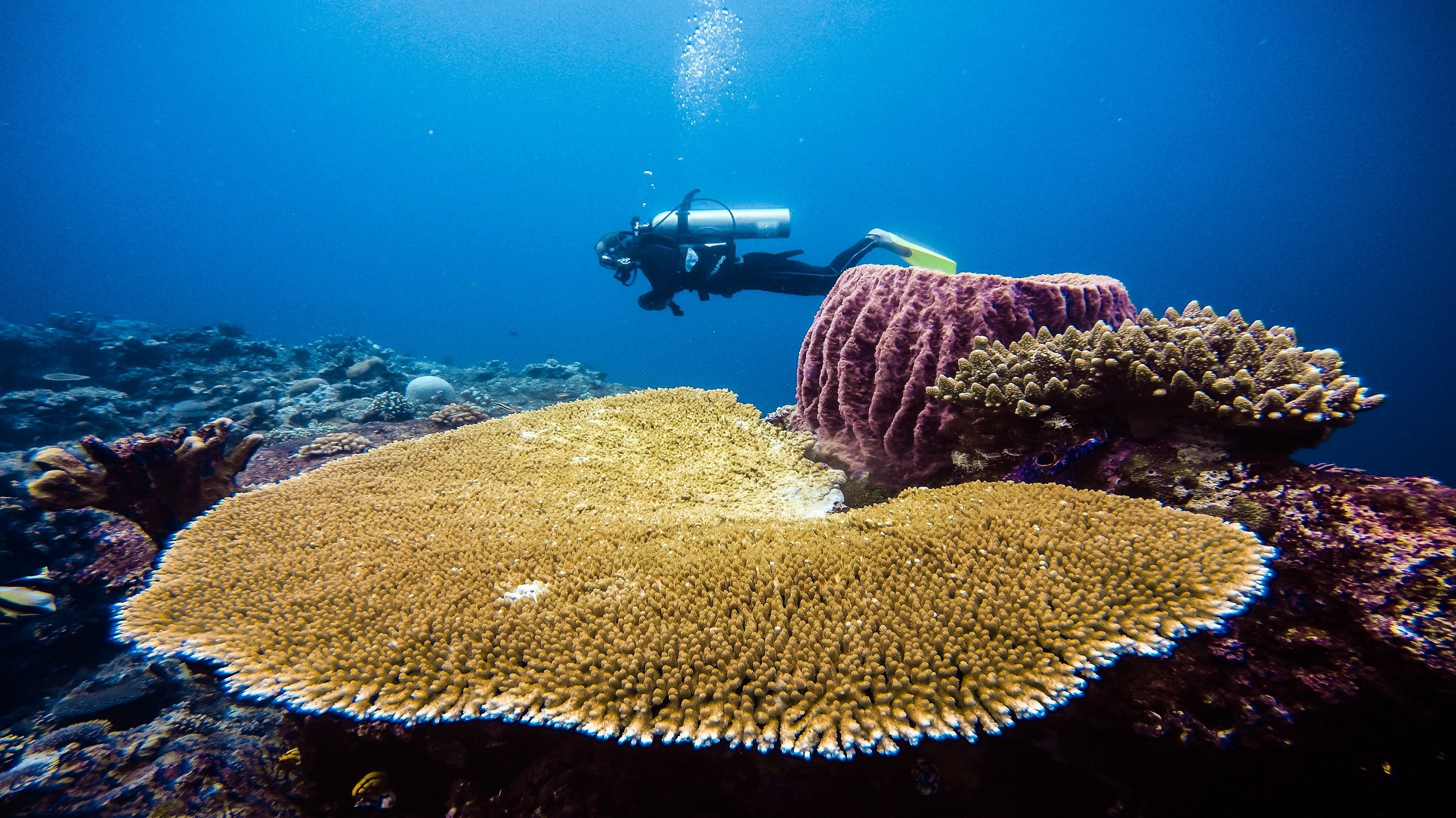 Lava FlowDeze bijzondere duik- en snorkellocatie ligt aan de noordkant van de vulkaan Pulau Hatta, op ongeveer 25 minuten varen vanaf Banda Neira.De laatste uitbarsting van de vulkaan, in 1988, veroorzaakte een lavastroom tot in de zee. De temperatuur van het water is daardoor sterk gestegen, hetgeen grote invloed heeft op de onderwater flora en fauna. In het ondiepe gedeelte floreert het koraal, iets dieper kun je Fusiiers, Parrotfish en zwarte Triggerfish spotten. In het diepe gedeelte, rond de 20-25 meter vind je Napoleon Wrasse, Batfish en met wat geluk de Mobula Rays... 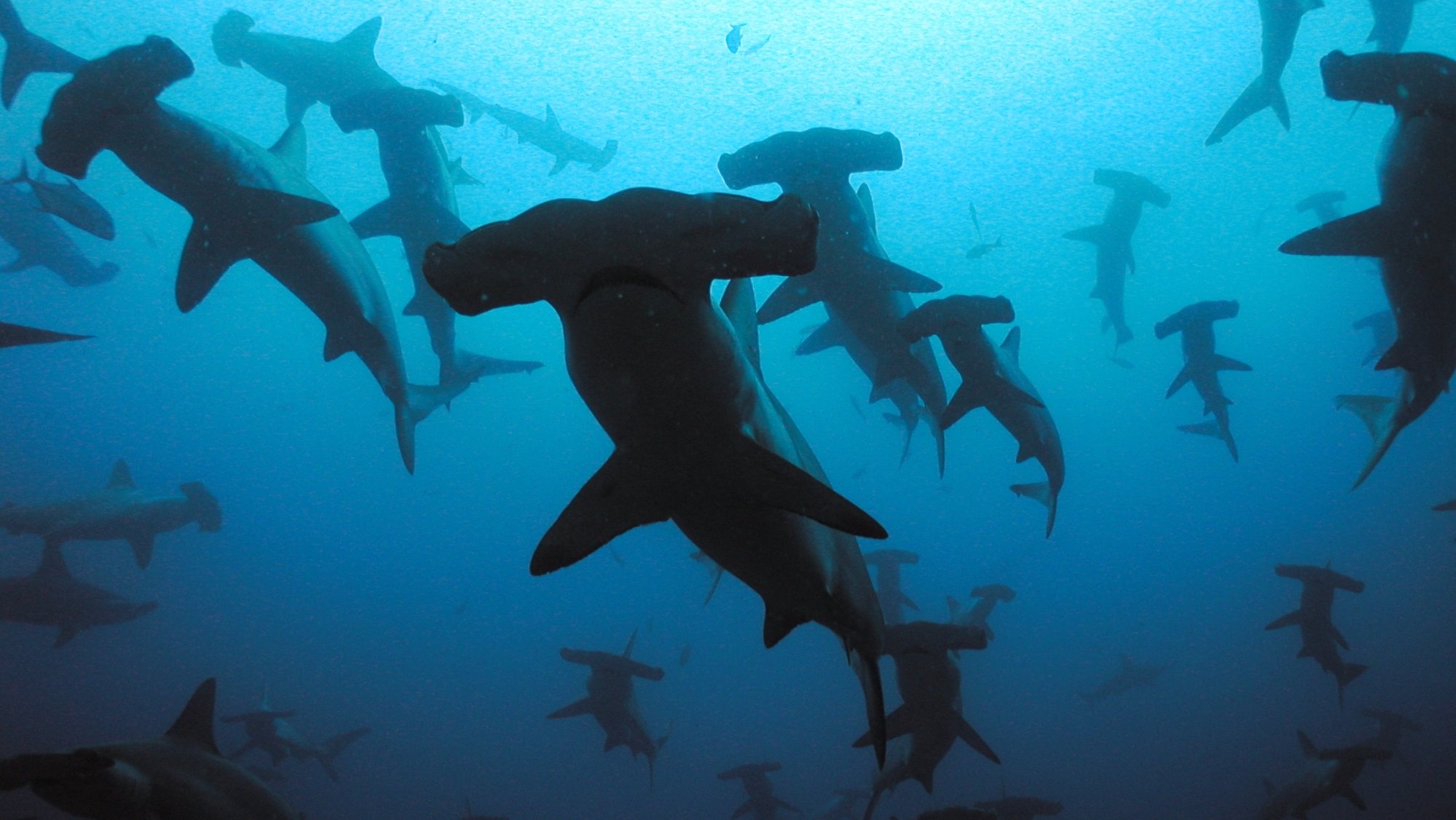 Hatta island25 km from Banda Neira. Skaru Atoll, is the name of a coral, few hundred yards south of the island, there are some colonies of unicorn fish, Fusiliers, jacks fish and rainbow runners, white-tip sharks measuring almost two meters, napoleon wrasse, dogtoothed tuna, and turtles.Pulau Hatta is known for its great snorkelling sites but it is even better for diving. In front of Hatta’s west shore beach, a 5 m wide hole in the reef top opens up to the open sea. You can dive down through it and will then find yourself looking back to what looks like a bridge on the coral reef. The bridge is covered with soft corals of all colours and underneath it, large Gorgonians that shelter a couple of Pigmy seahorses. You can continue the dive as a relaxed drift along the wall, one of Banda’s most diverse sites in terms of reef fish, shrimps, molluscs and corals. Sea turtle encounters are also quite frequent in Hatta. Hatta’s other dive sites are similar to the wall of Hatta bridge. Fish and coral diversity is great everywhere, including schooling barracudas, batfish, Napoleon wrasses and much more. Karang Hatta is a reef located South East of Pulau Hatta. Its dive sites are the nearest sites to the 6000m deep Banda trench, which makes diving interesting as the chances to see big pelagics are the best here. Schooling trevallies, barracudas, tunas and even chances to see bigger sharks (hammerheads and grey reef sharks), as well as many turtles can be seen around this underwater mountain. The reef surface had been bombed years ago but is showing good signs of recovery already. 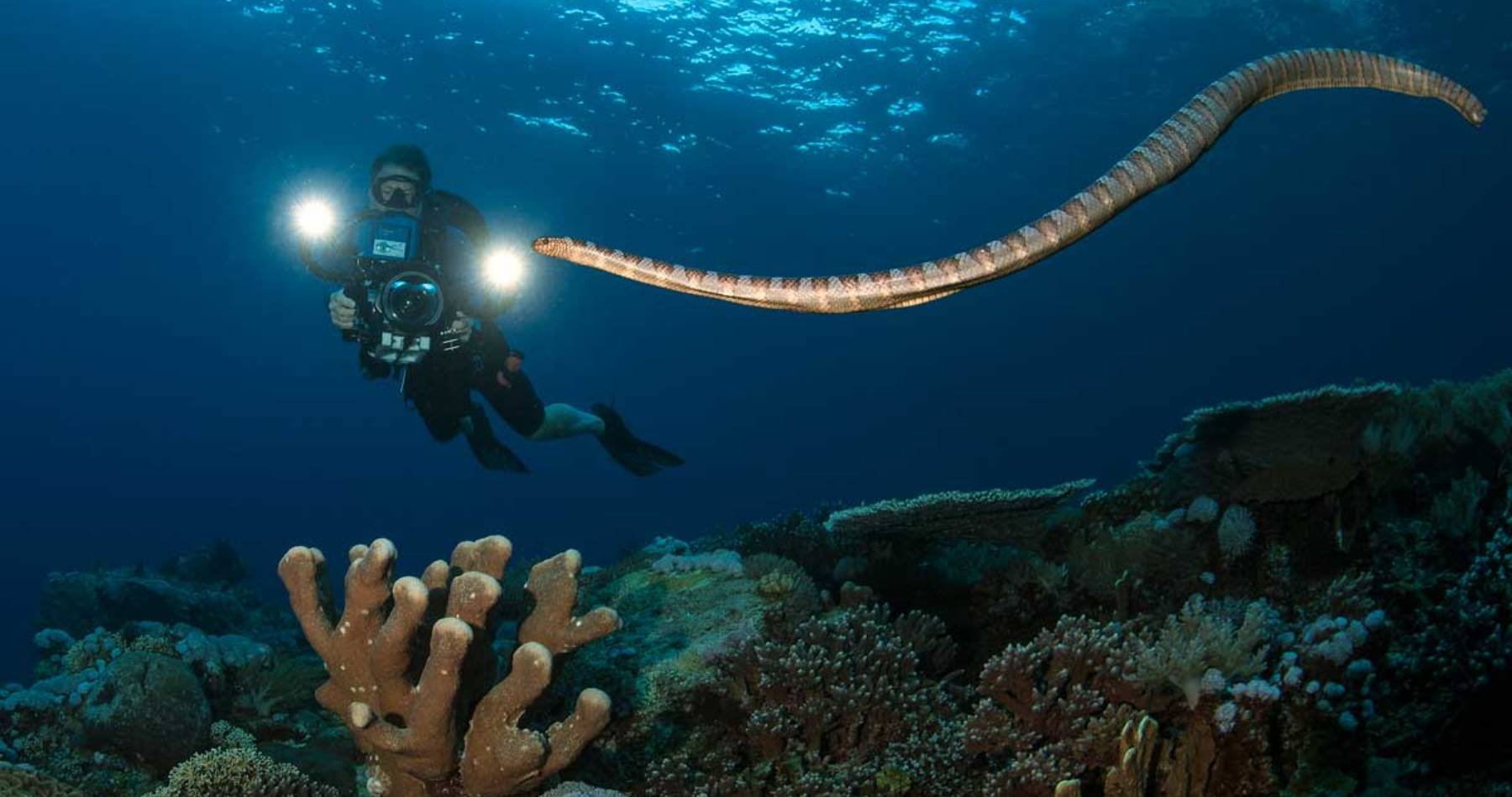 Pulau AiAi Island: north and south-west coast surrounded by beautiful reef wall, full of caves also the habitat for fish in the harbours. Just as Pulau Hatta, Ai offers some of Banda’s best reefs. The northern sites of the island, for example the dive site Batu Payung (= Umbrella rock), have a rather steep wall with lots of cracks and overhangs whereas the southern reef areas are sloping down to the sandy bottom at 40-50m. In the south of Ai, occasionally Hammerhead sharks have been spotted, giving this dive site its name “Hammerhead point”. Napoleons and turtles can also often be seen here.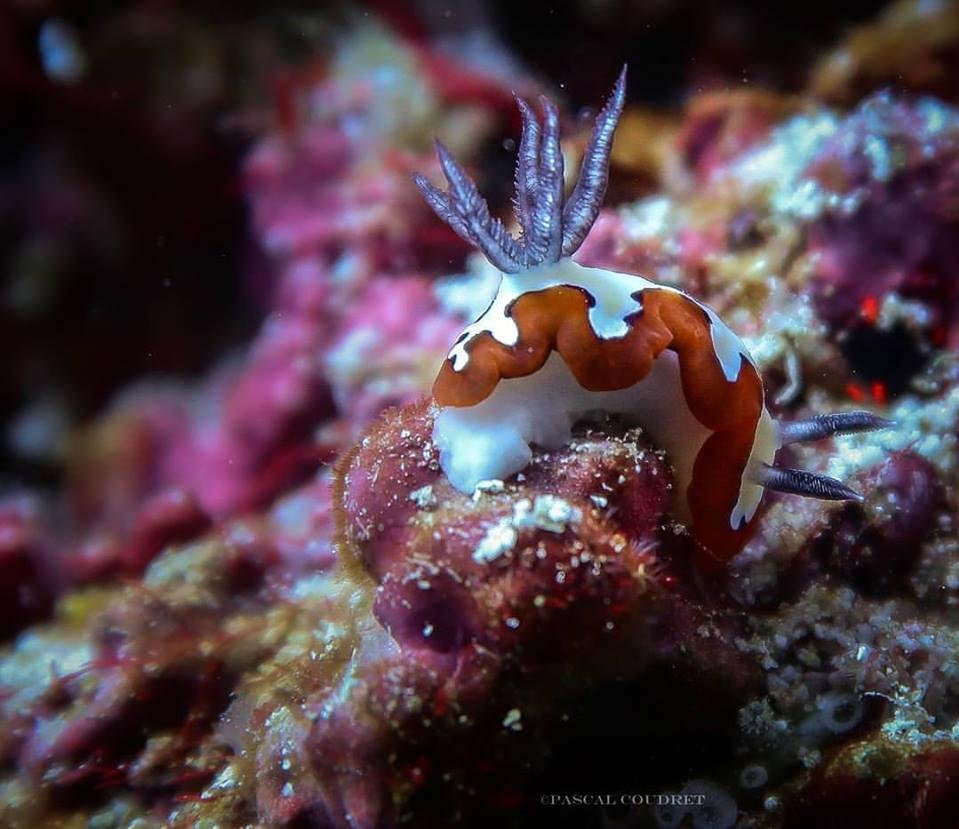 Karaka IslandKaraka Island of Crab Island ligt op korte afstand van Gunung Api. Het noordkuststrand is perfect voor een picknick. Pulau Keraka, ook bekend als Lighthouse, biedt een zeer interessante diversiteit aan zeeleven. Stromingen zijn hier zelden sterk, waardoor het een zeer makkelijke site is om te duiken en foto's te maken. De mix van rotswanden, koraalblokken op een zandbodem en een rijke riftop biedt een verbazingwekkende verscheidenheid aan kleine beestjes zoals snoepkrabben, naaktslakken, Ornate Buikbek-vissen, Bladschorpioen-vissen en nog veel meer, waardoor deze site de favoriet van een macrofotograaf is, voor zowel overdag als 's nachts duiken. En als het je lukt om je blik van de kleine beestjes af te wenden, zul je ook Giant Moray Eels, Great Barracuda's in het blauw zien zwemmen, Napoleon Wrasses, schildpadden en nog veel meer.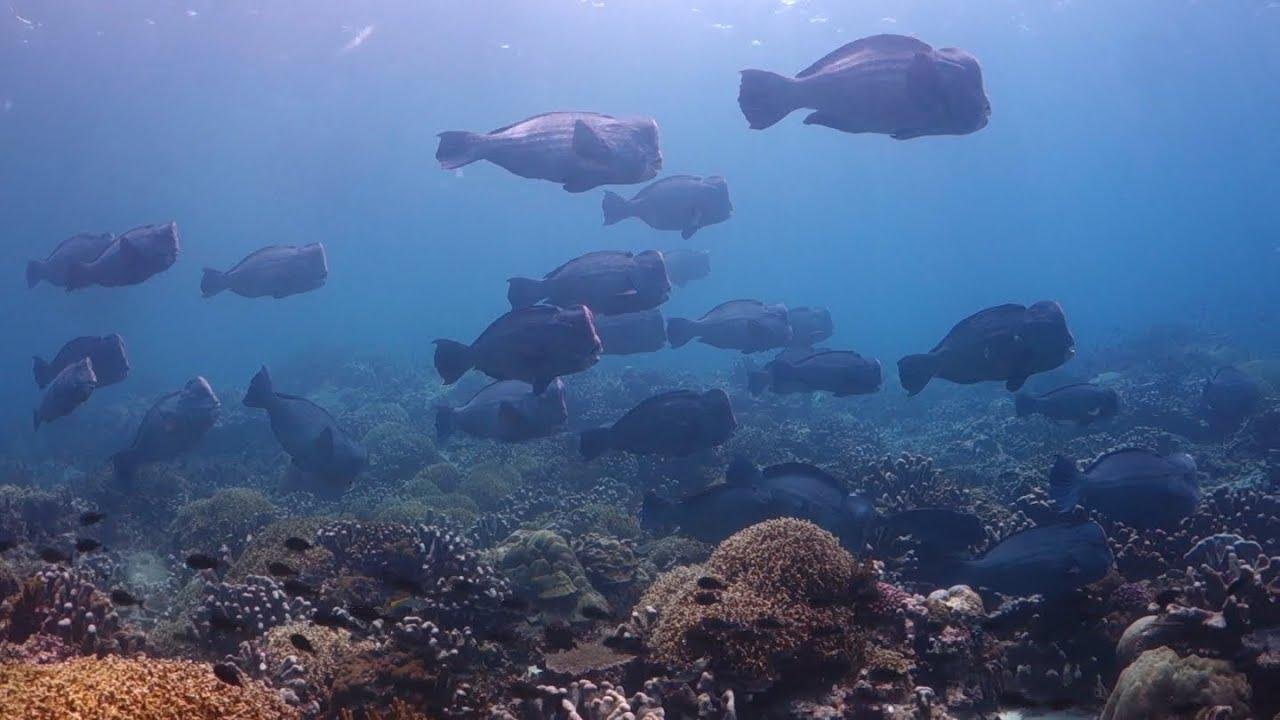 Pulau RhunThanks to its remoteness, Rhun and the little island of Nailaka offer outstanding reefs and large amounts of fish. After putting your head under water and having had lunch on the beautiful white beaches of Nailaka you will definitely have forgotten the 2 hour boat ride it takes to get there.Saparua duikstekken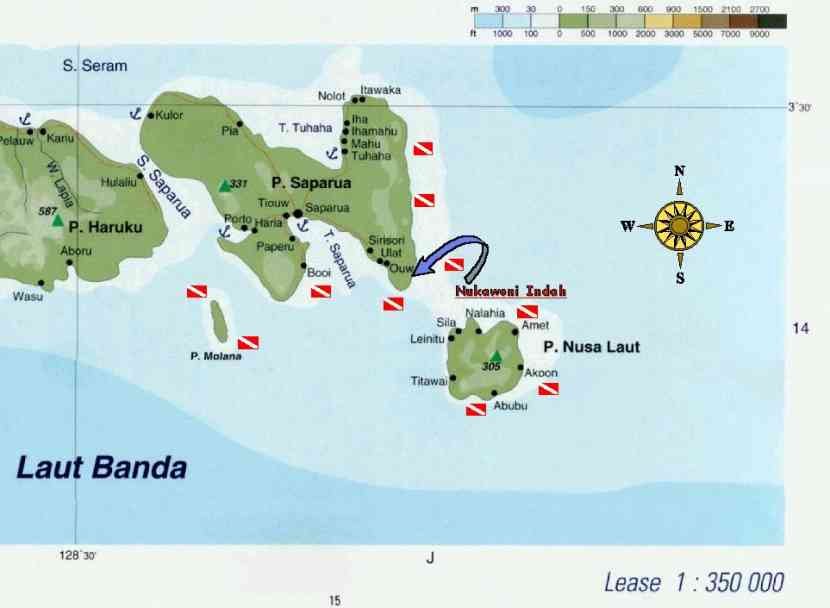 Duikinformatie Saparua en omgevingBeste duikperiodes rondom Saparua en de overige Lease eilanden zijn van februari tot mei en september tot en met december. De watertemperatuur is constant tussen de 27 en 30 graden. Het zicht kan oplopen tot 40 meter in het voorjaar. In het najaar is het zicht wat minder door het rijke plankton.Dive spots Ambon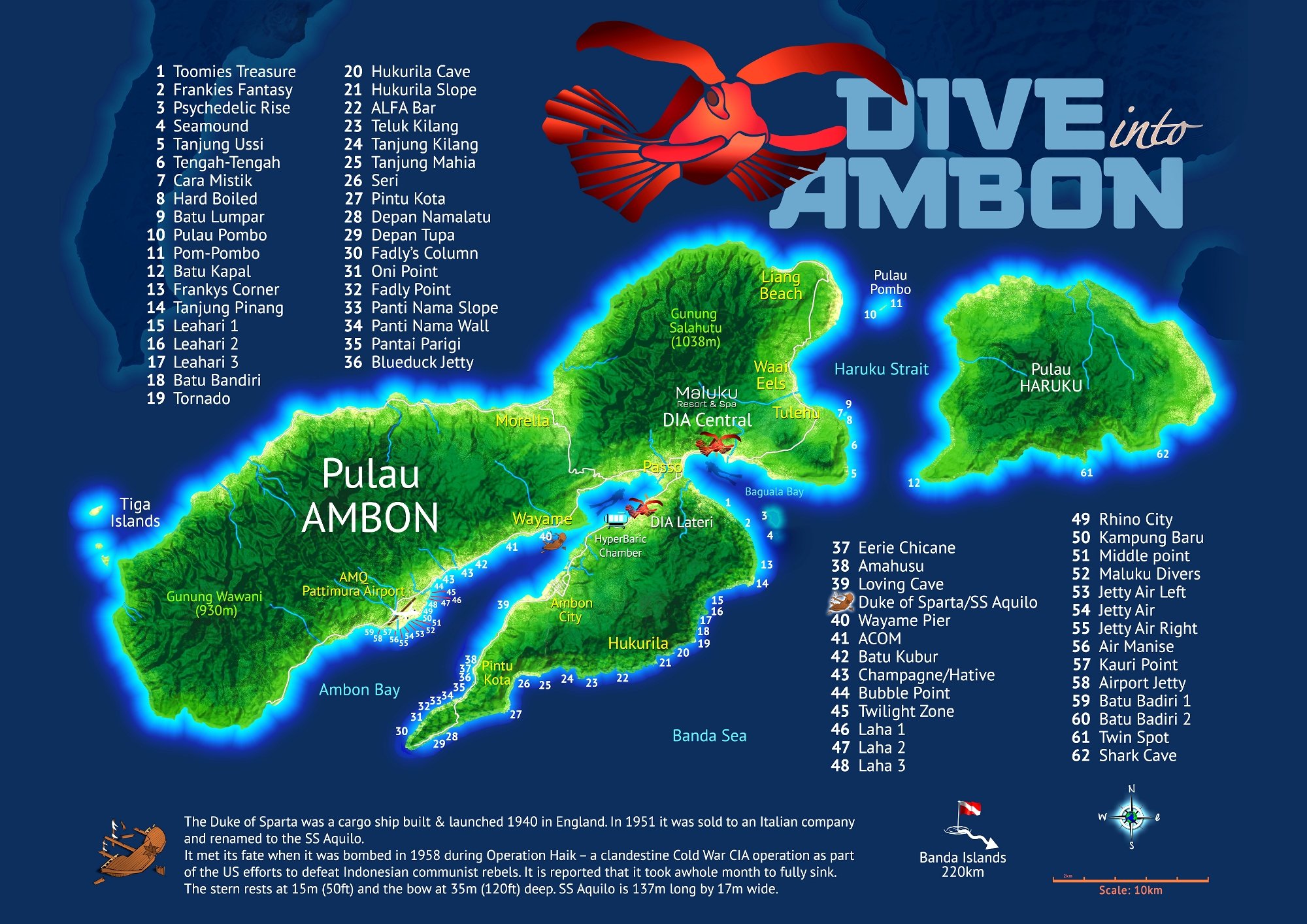 Dive spots AmbonDive Season: The best months for diving are September to December and March to April but also the months between. The Moluccan islands have the seasons reversed from the rest of Indonesia, when they have the dry season, its rainy season in Indonesia.Visibility: Usually is good (20-30m) except some muck sites close to the harbour or where sand is easily stirred up. Water Temperature: 20C/68F – 27C/80F Skill Levels: Dive sites are available from beginner through advanced. Dive Access: Land based diving, boat diving and shore diving. Many live-aboard start and end their itinerary in Ambon. Good option to add land based diving at the beginning or ending end of you live-aboard trip. 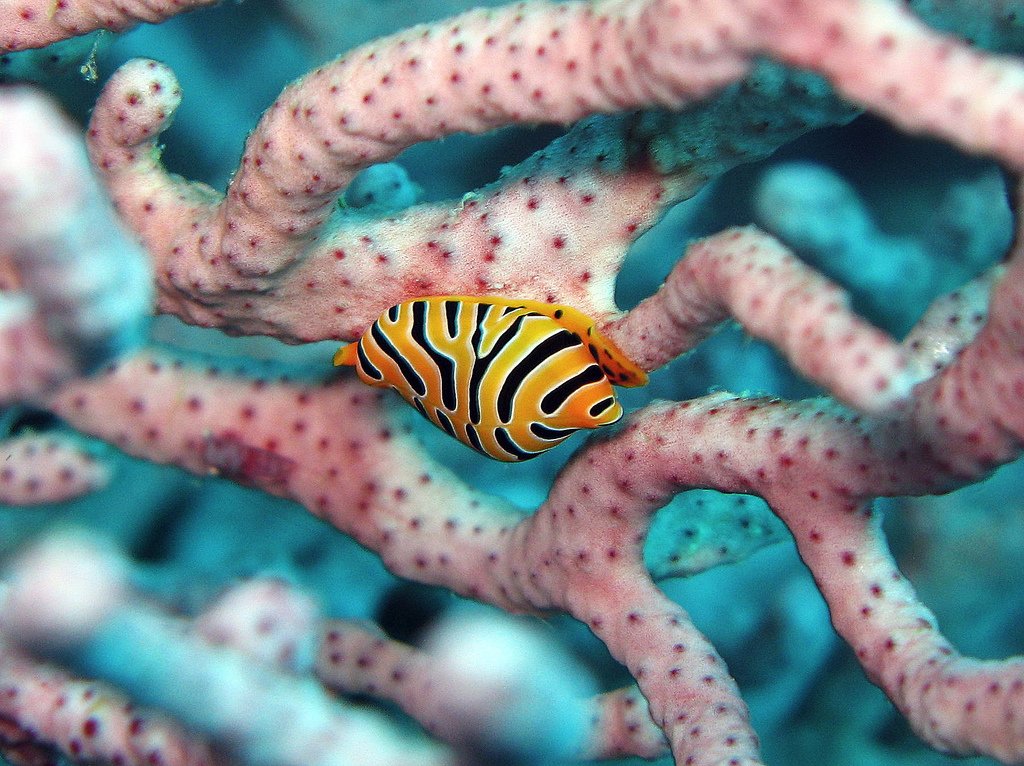 Ambon Bay - Kauri PointYou dive on a slope covered with sand and rubble. Among the stones there are small sea fans where lots of Kauri snails are living. We found a total of four different species just on this dive site, among them the beautiful tiger Kauri (Crenavolva tigris) and some kauris that look like they are part of the coral (Prosimnia piriei and Phenacovolva rosea) and are usually rather difficult to find. On another sea fan dozens of small porcelain crabs and several species of spider crabs were crawling about.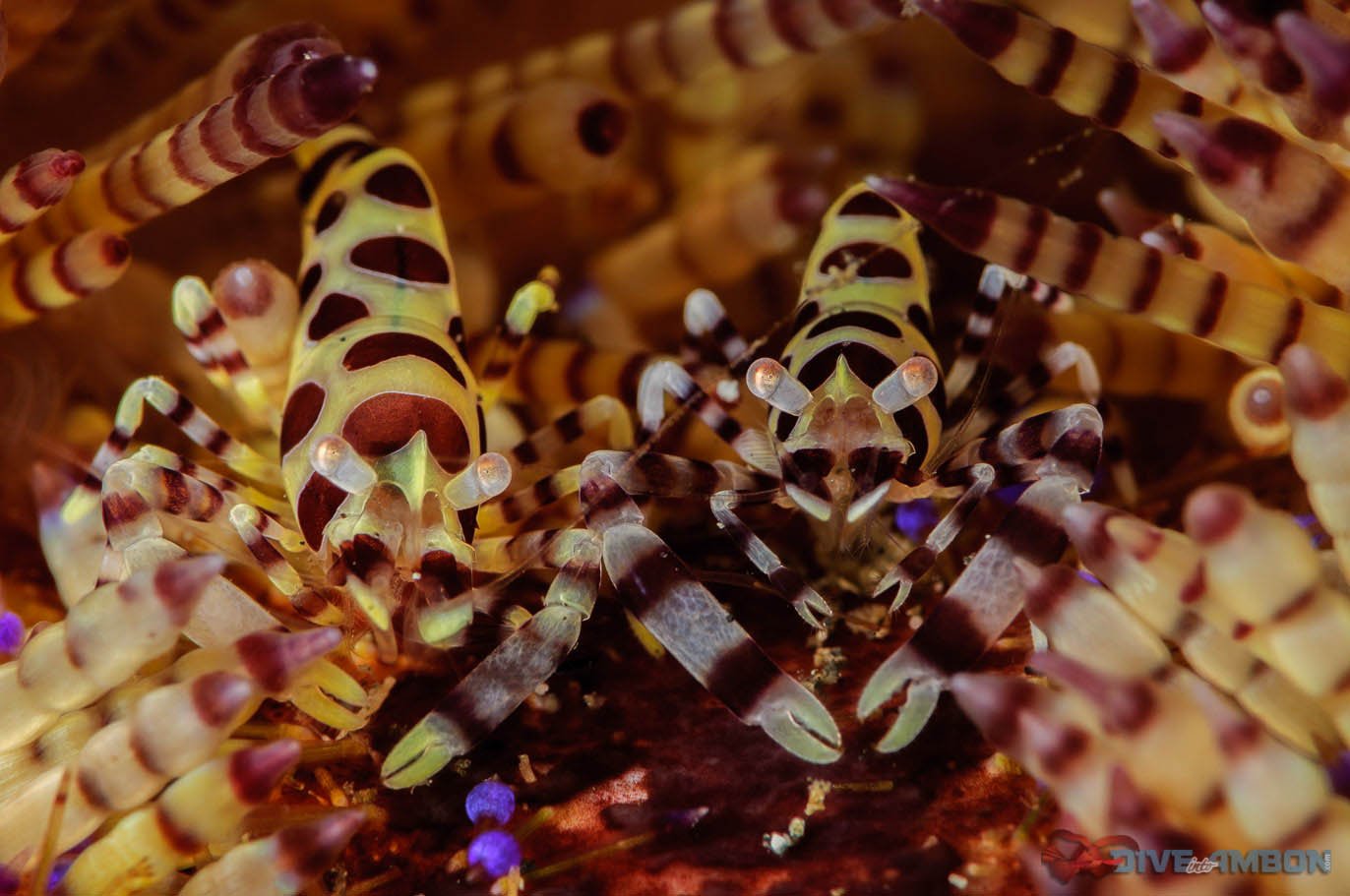 Middle point - Ambon BayA rubble slope with a lot of waving soft corals on the top and special sponges that look like grayish leaves. There is a large coral block with leaffishes and lots of cardinalfishes on about 17m and we got stuck there because there were so many photo opportunities. Some of the cardinalfishes had eggs in their mouth and two pufferfishes were circling and fighting. Further down our guide found a pair of Halimeda Ghostpipefishes (Solenostomus halimeda) nearly invisible among the Halimeda plants and another single one the same color as the special sponges. Part of this dive site was covered with the colorful poisonous sea urchins (Asthenosoma ijimai), some with Coleman shrimps (Periclimenes colemani), some with Zebra crabs (Zebrida adamsi) or both.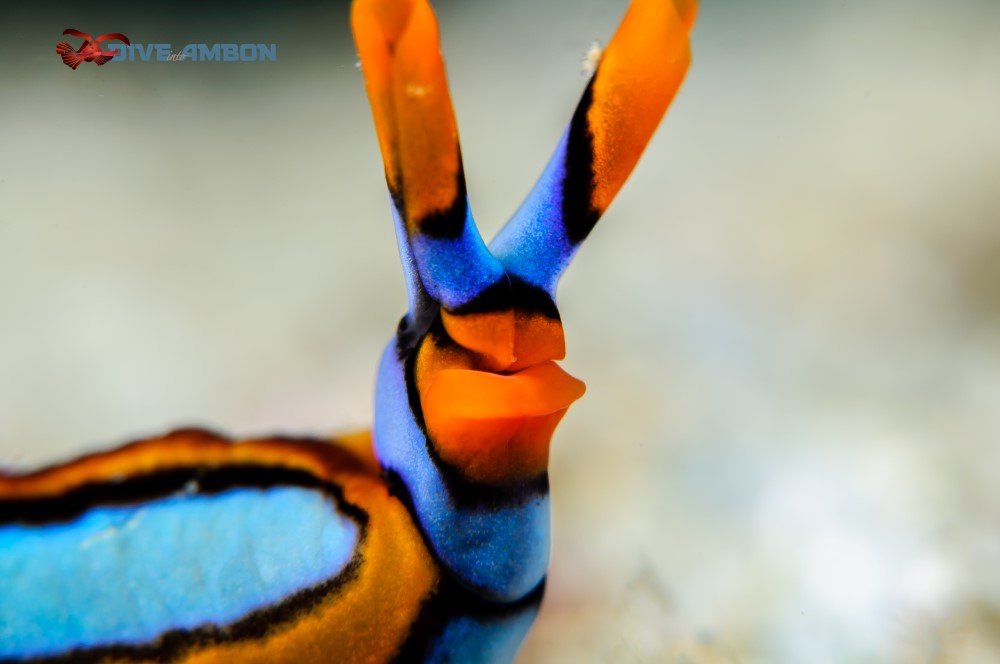 Ambon Bay - Jetty airportThis dive site is underneath a long pier which lies just past the end of the airport runway. There are always large schools of small fishes and juvenile batfishes between the columns covered with sponges and on the sand you find small critters like nudibranchs, morey eels, lionfishes and sometimes Rhinopias scorpionfishes.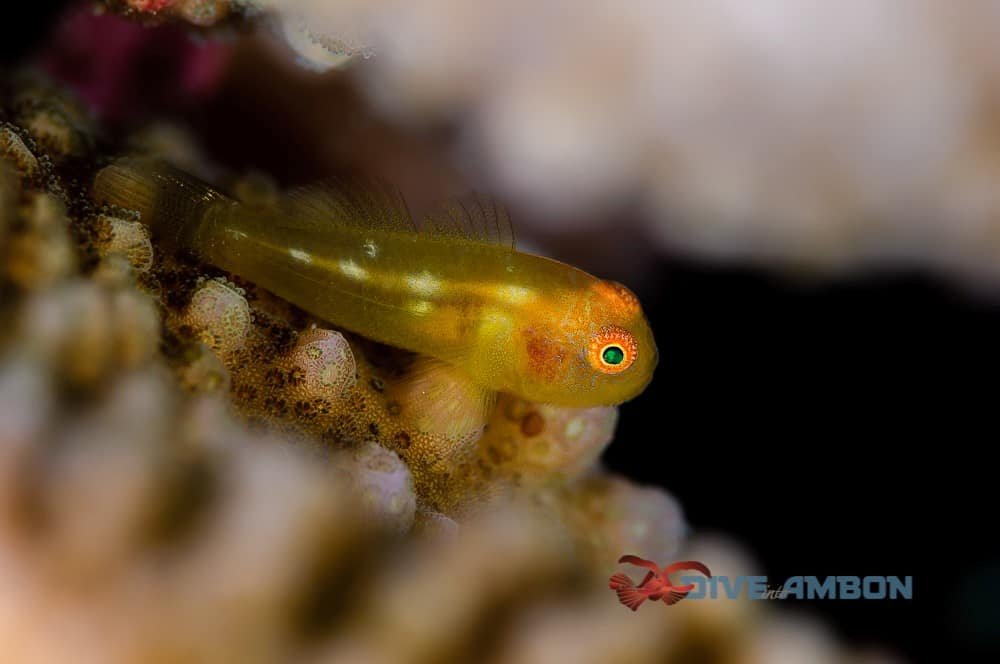 AIr Manis - Ambon bayIt is a working jetty, so there were boats overhead. Underwater there is some rubbish around, but also plenty of interesting critters. A special find were the shy yellowhead dwarfgobies (Trimma stobbsi) and a Lined Fire Worm (Pherecardia striata), about 20cm long.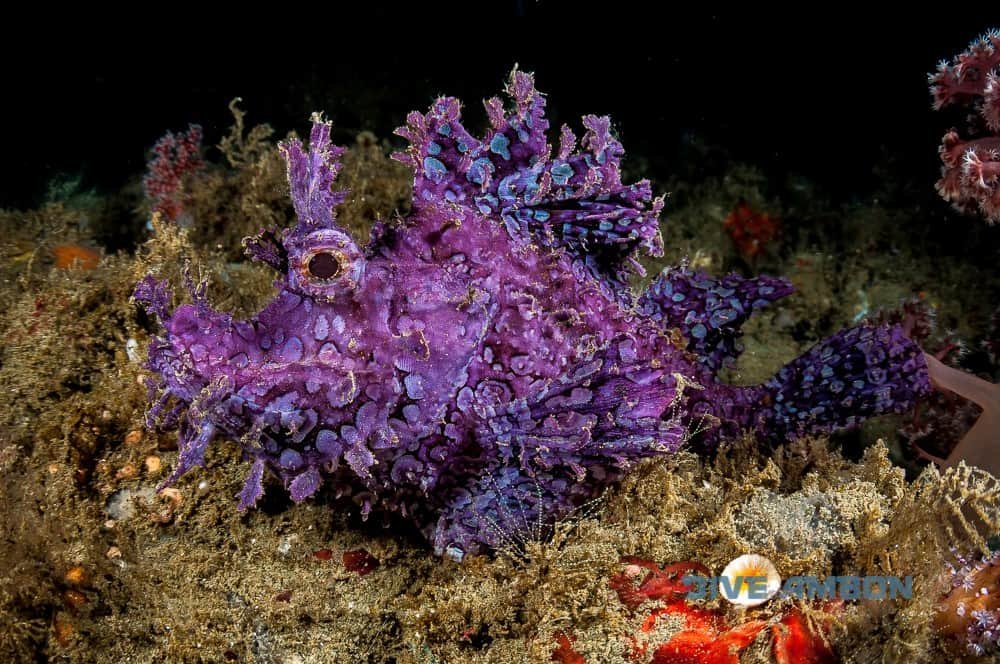 Rhino city - Ambon BayThe whole area from Rhino City through the Twilight Zone to Laha 3 is a great place for diving. The dive sites are basically slopes with stones, patches of corals, sponges and soft corals. It seems to be one of the places you regularly find the exquisitely colored Rhinopias scorpionfishes. These beautiful animals come in yellow, blue, red, pink to peach and brown and are actually not very shy. There is a lot of confusion about the three Rhinopias species. In Indonesia you find only the weedy Scorpionfish (Rhinopias frondosa) and Eschmeyer’s Scorpionfish (Rhinopias eschmeyeri)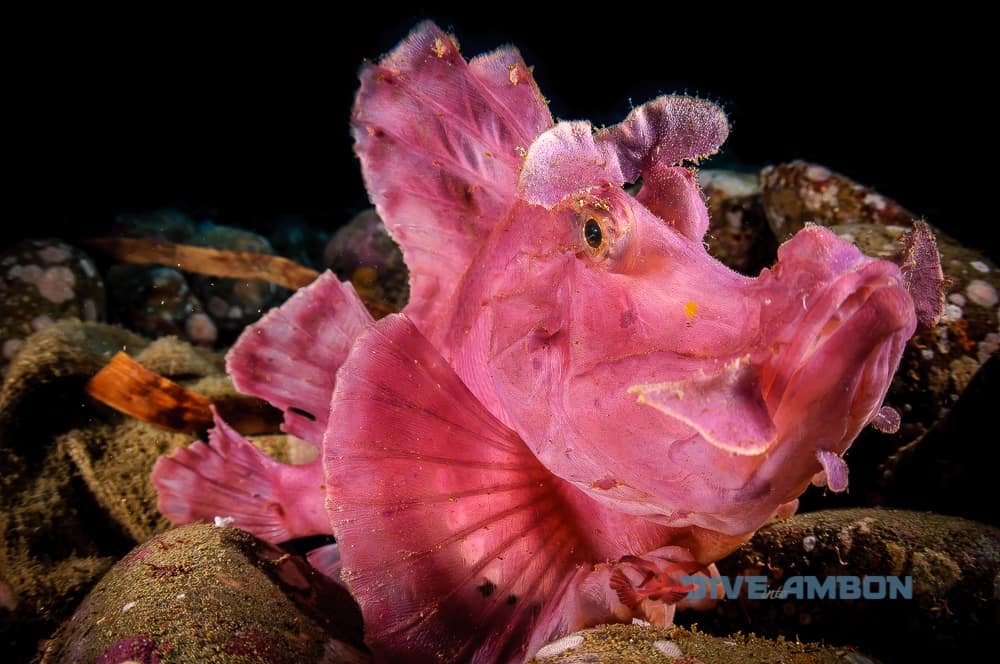 Kampung baru - Ambon BayDeze duikstek ligt net buiten het dorp, op een plaats waar de boten aan het anker liggen. Je begint op zand en zwemt dan naar een helling met veel stenen, sponzen en wat koralen. Tegen het eind keer je terug naar het zand waar enkele grote koraalblokken liggen. We hadden geluk en zagen twee Rhinopias (schorpioenvissen) in dit ondiepe gebied, dus we konden veel tijd met hen doorbrengen. De roze heeft een vis ingeslikt terwijl we toekeken - maar veel te snel voor de fotografen!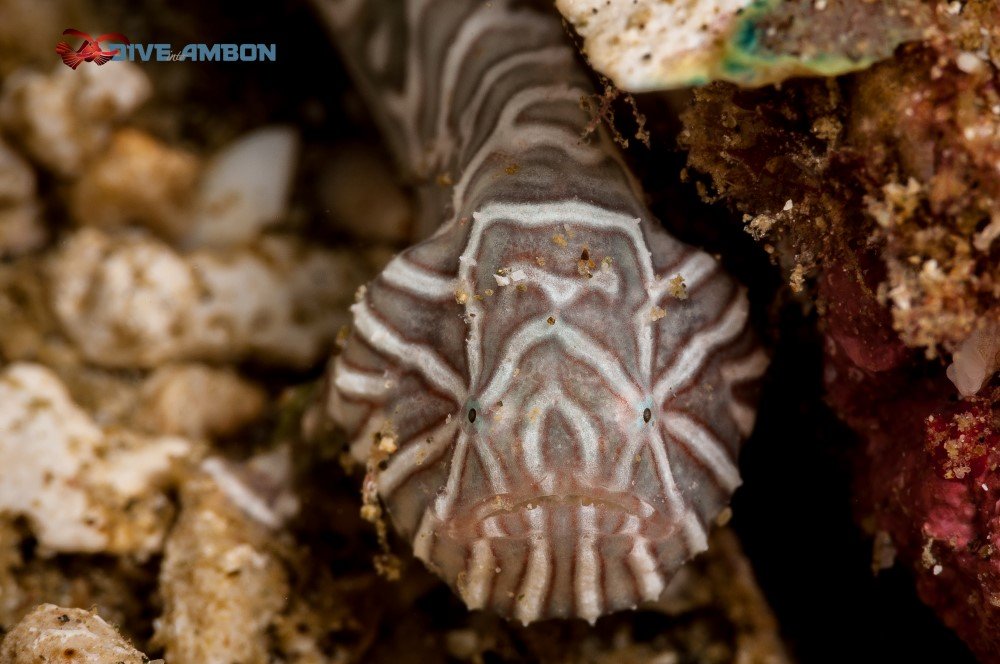 Twilight zone - Ambon bayThe area from Laha 1 to Laha 3 is also called the Twilight Zone. This are is also the area, where the psychedelic frogfish (Histiophryne psychedelica) was found. A slope covered with stones and small sponges, corals. Lots of frogfishes, nudibranchs and slugs and sometimes flamboyant cuttlefish, jawfishes, lots of gobies, small crabs and shrimps and ghostpipefishes to be found.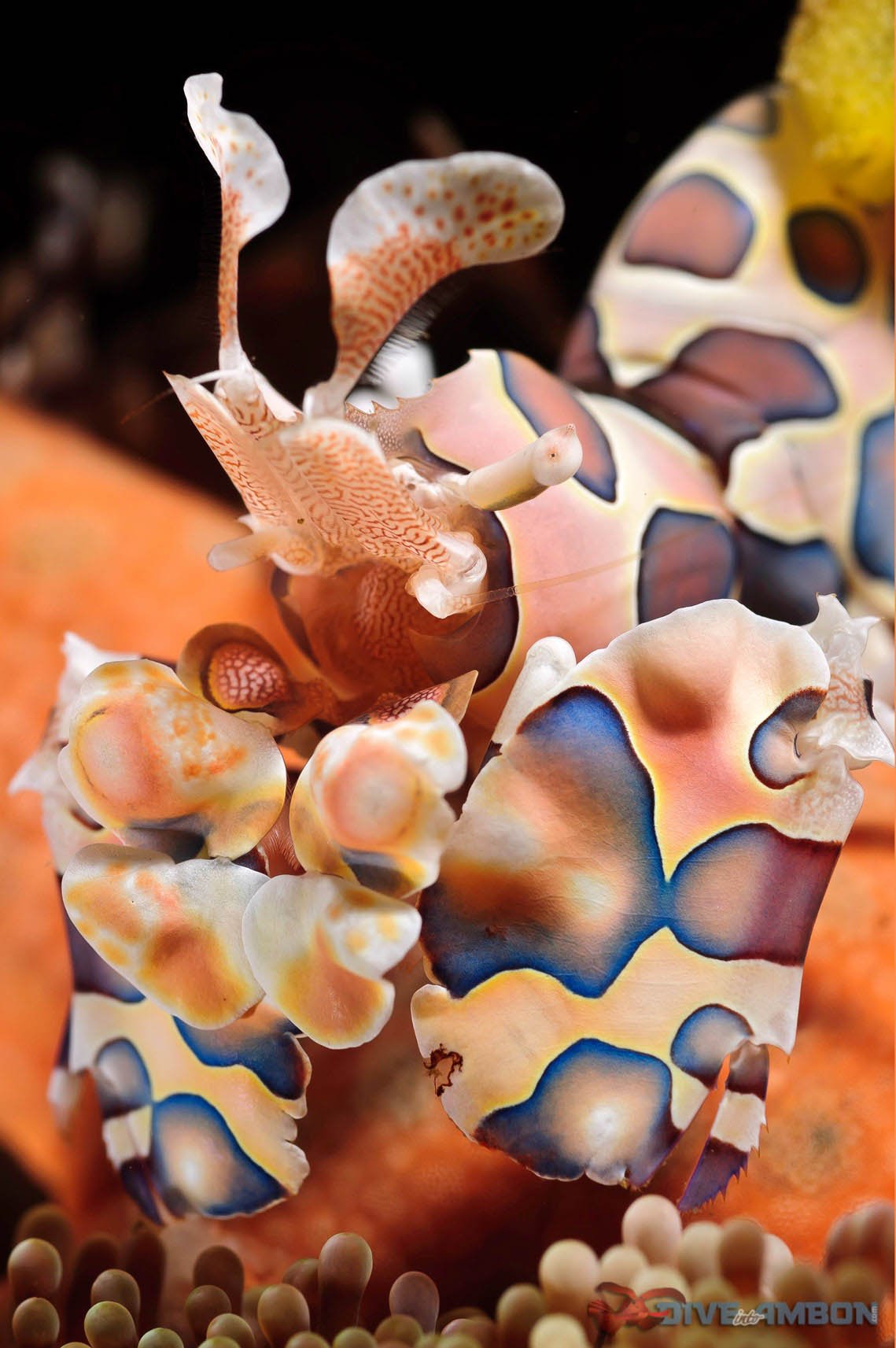 South East Ambon - Pantai ParigiThis dive starts about 100m south of the jetty. It is a steep slope covered with nice corals and large sponges and with some sand coming down in channels. After a while the slope turns in a wall with nice small crevices and large coral outcroppings. There are a lot of bryozoans and small hydroids growing on the wall and everywhere are blue and yellow tunicates. Between we found nudibranchs, a harlequin shrimp and a juvenile frogfish. At the end of our dive everything was covered with Black Triggerfishes (Melichthys niger) and mackerels darting among them.Ambon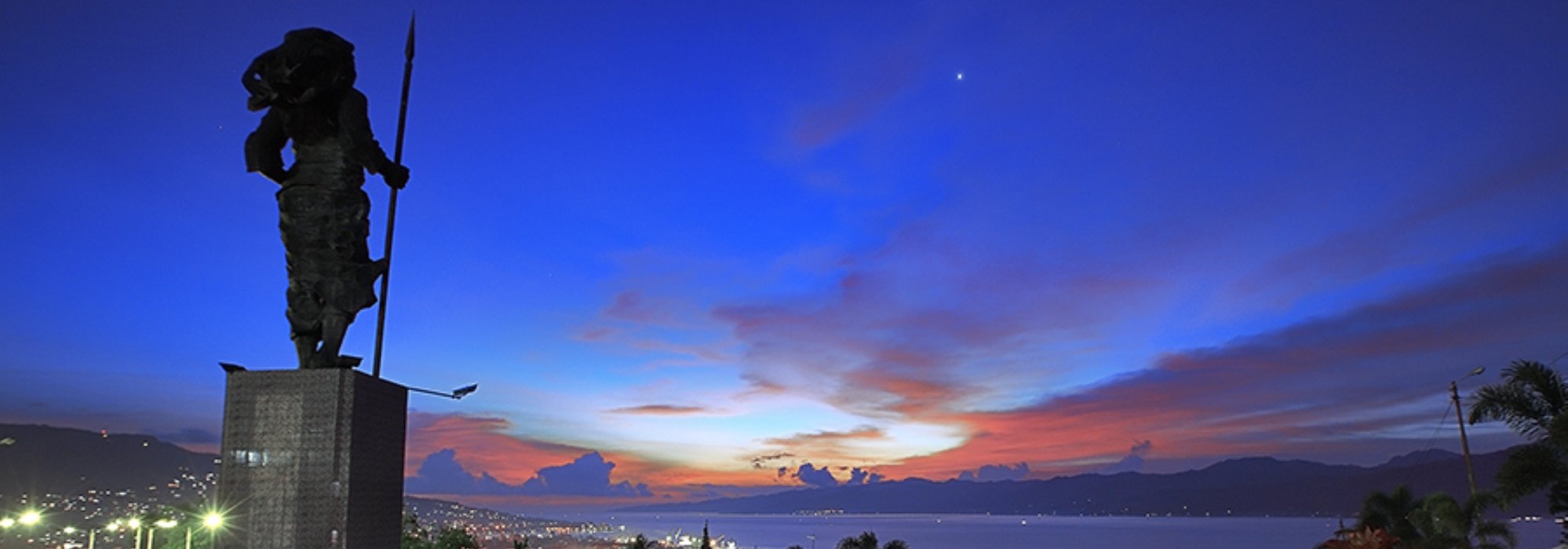 AmbonAmbon, the capital of the South Moluccas island group, is located on the island of Ambon of the same name.The pleasantly busy city of Ambon is ideal for a tour by becak (bicycle taxi). The colorful market, the Merdeka square with the World Peace monument and the statue of the freedom fighter Pattimura are nice sights. A little further away is the statue of Martha Christina, Pattimura's female ally. If you have a car available, also drive to the village of Soya di atas and take a drink of water. It seems that it makes you a lot younger. The Siwalima museum is also worth a visit and is on the route to Pintu Kota, the iconic gate of Ambon. Ambon town has great appeal to young people from the surrounding villages and islands, making the population very young. They mainly come to look for work. The main employer in Ambon City is the government and a civil servant job is highly sought after as it provides security, status and benefits (such as being able to help family members). But for Moluccans who have lived or were born in Ambon for a long time, the village of origin (of the family) remains very important for identity. At important village events or on public holidays, many Ambonese return to their families' village. In terms of accommodations, you can choose from city hotels, such as the new Santika with swimming pool and the cozy family hotel Mutiara. If you want to be outside the city, the Maluku Spa Resort in Natsepa, more than half an hour's drive from the center, is the best choice. Ambon city is by far the most important hub of the province and plays an important role for the whole of East Indonesia. Across the Bay of Ambon (Teluk Ambon) is Pattimura airport with scheduled flights to Makassar, Jakarta, Surabaya, Bali, Ternate and Papua. In addition, a number of Pelni passenger ships call at the city. 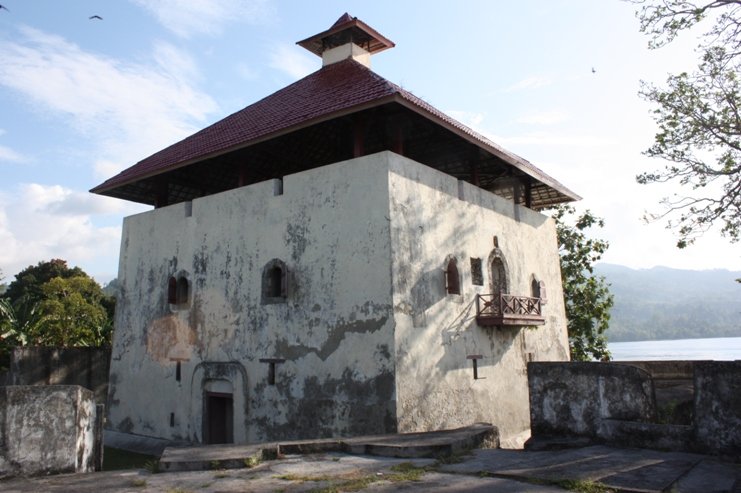 Ambon out of townOn the northern peninsula of Hitu is the reasonably preserved Fort Amsterdam. A short distance away you will also find the oldest mosque and church of Ambon.In the east of the island lies the village of Waai with the famous sacred eels. Nearby are the hot springs of Tulehu and the lovely white beach of Liang. Public transport on the island itself consists of the Angkotan Kota, small buses that serve many destinations on the island from the Mardika Terminal near the center of the city. 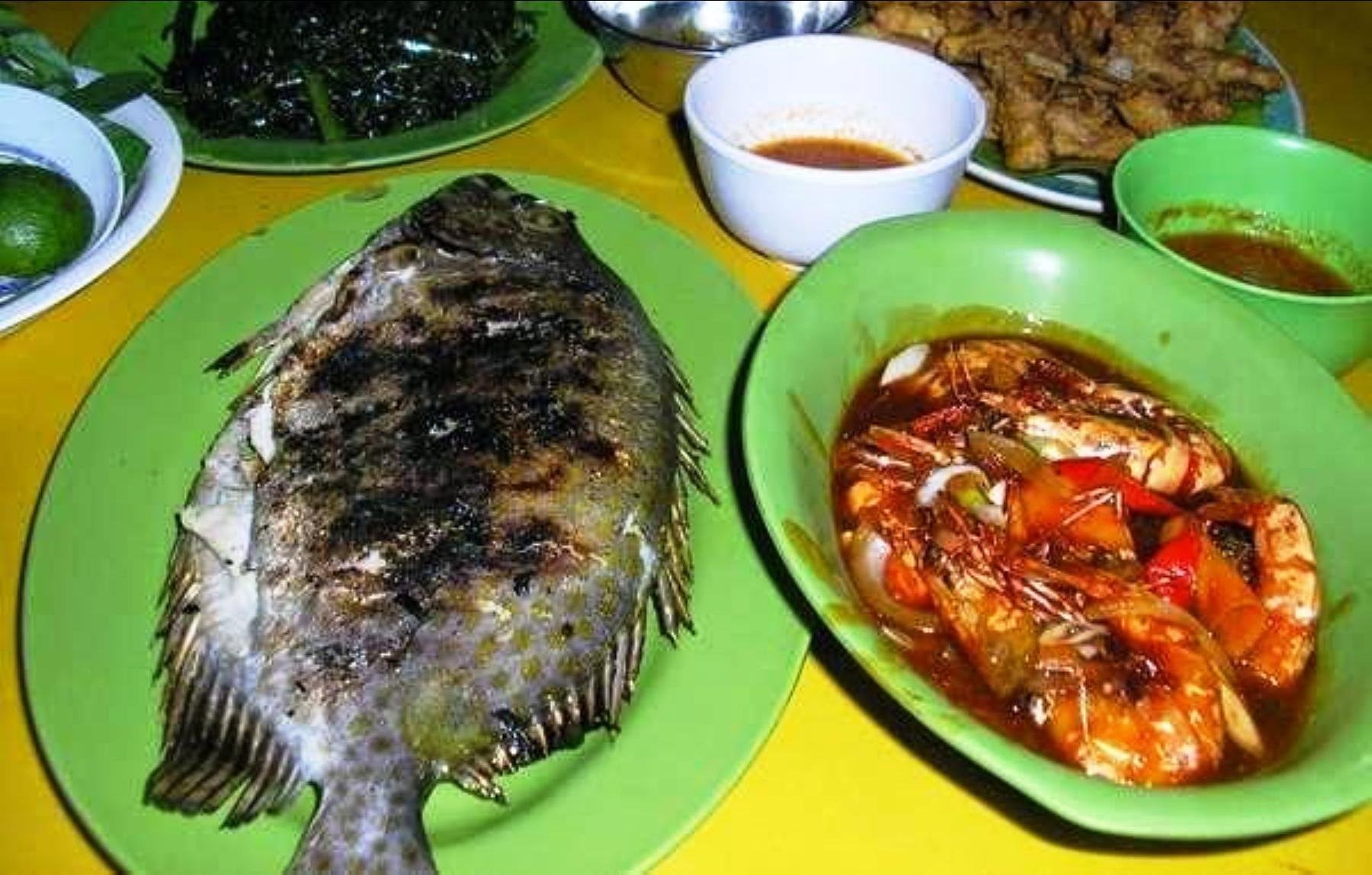 Favoriete restaurantAmbon city has very nice fish restaurants. Me myself would recommend Rumah Makan Ratu Gurih, busy on the weekends, but during the week you can eat the tastiest ikan goreng or ikan bakar (deep fried or grilled fish).Be sure to have a coffee at Rumah Kopi Sibu Sibu and get amazed over the nice pictures and interior. 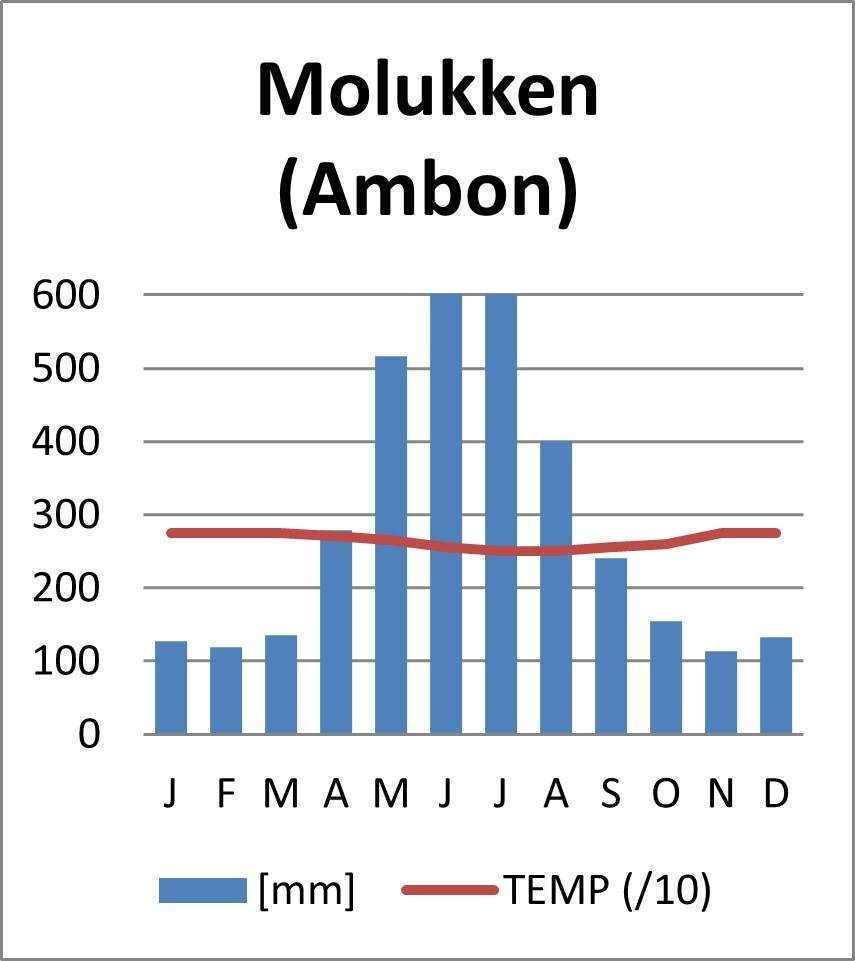 Klimaat |

